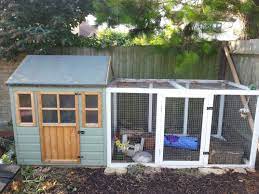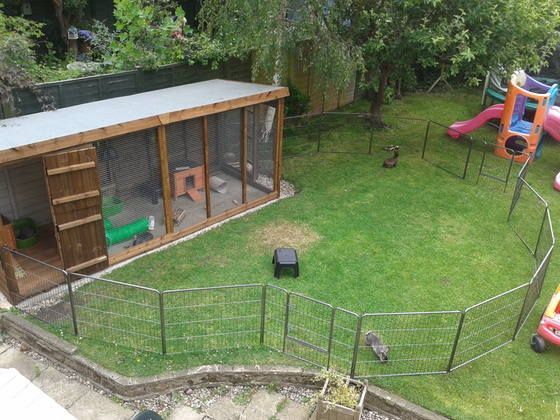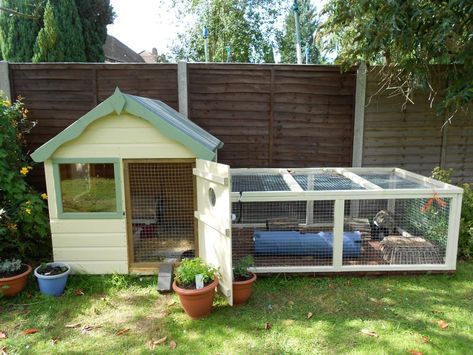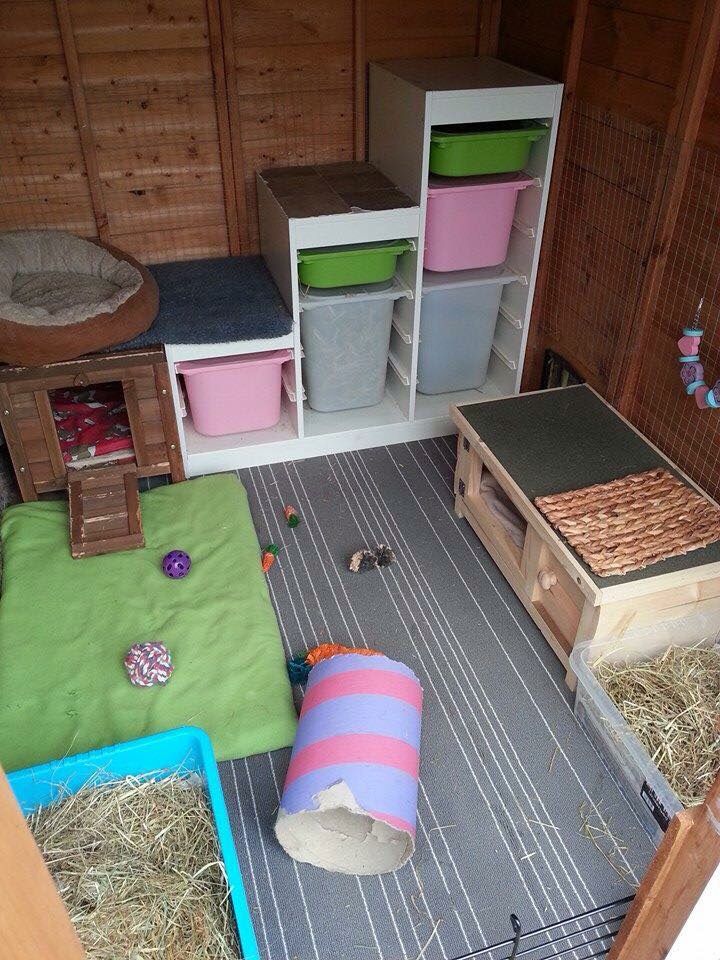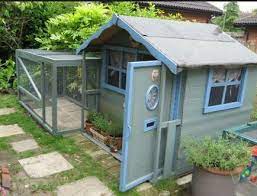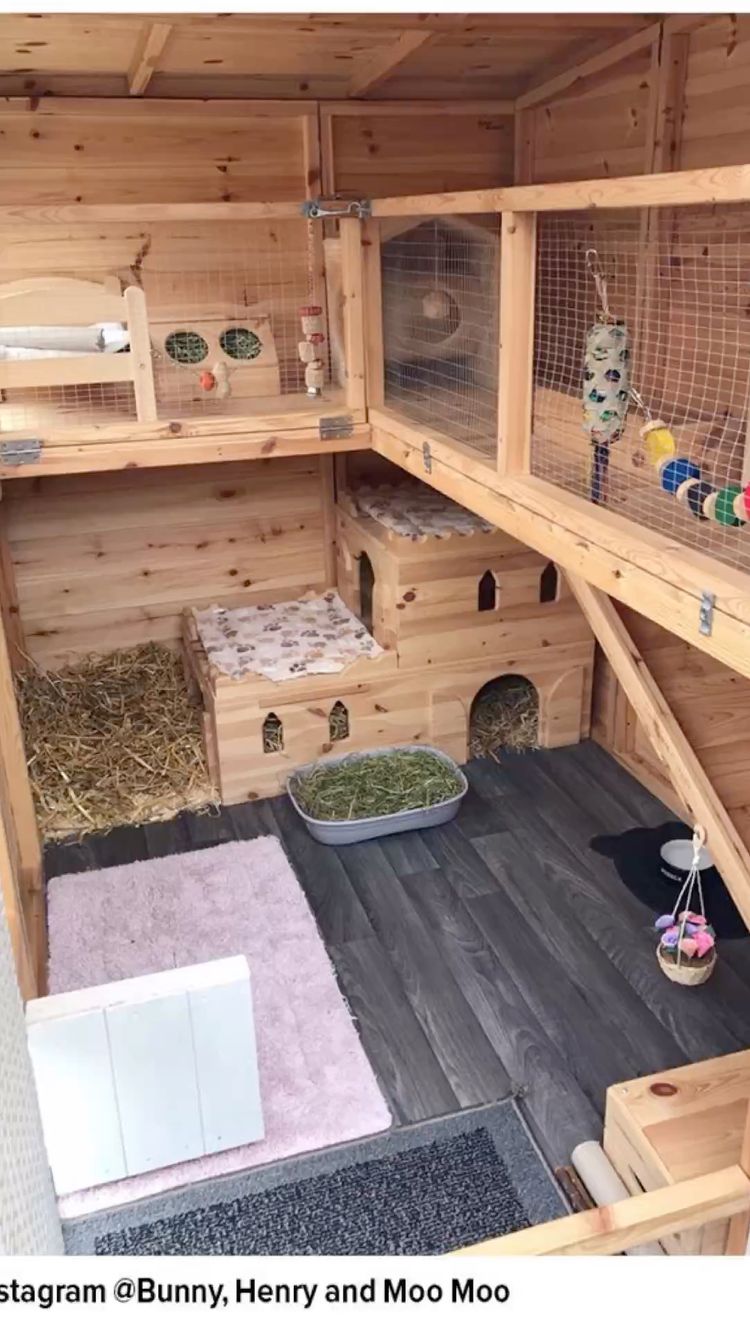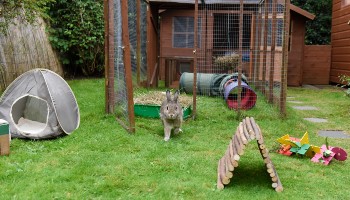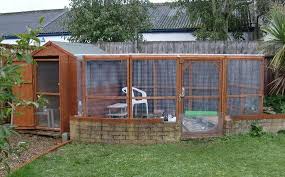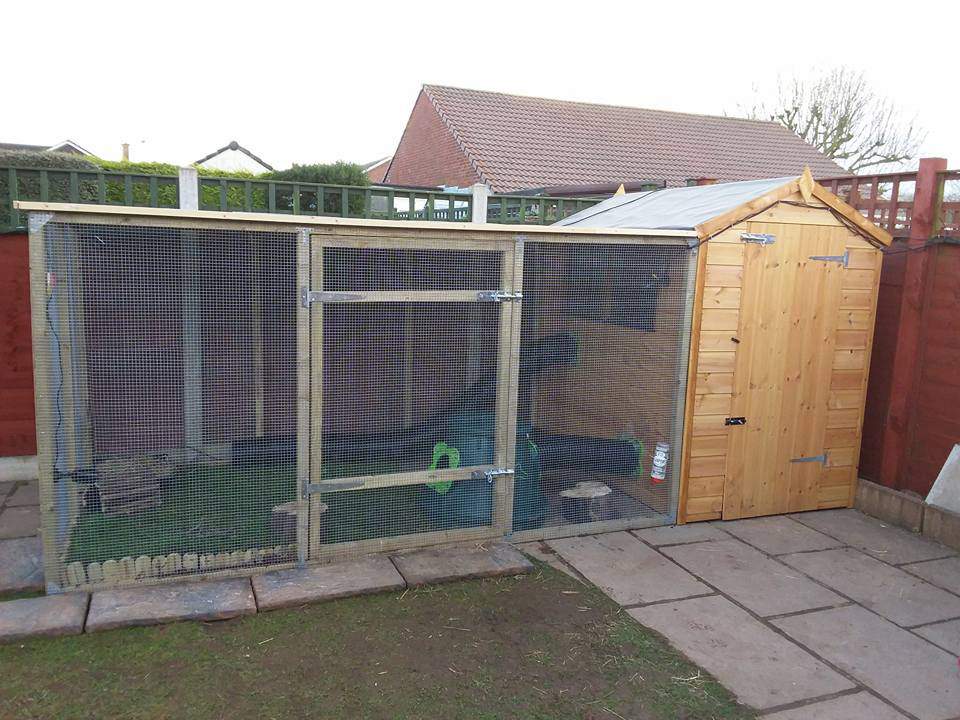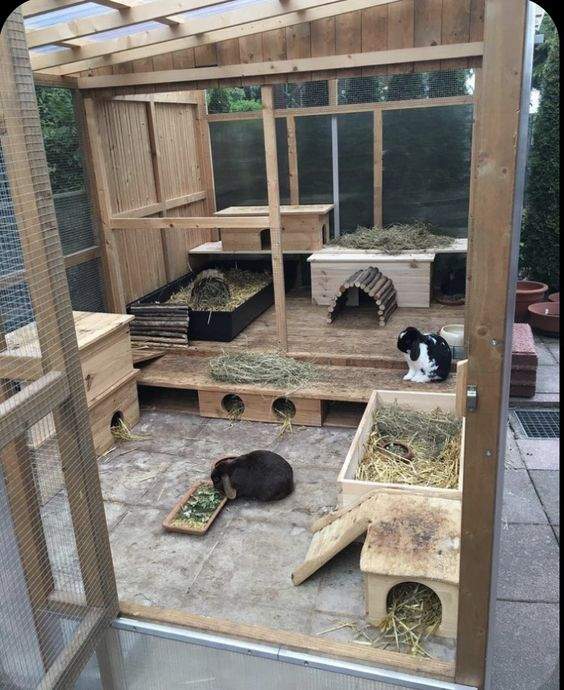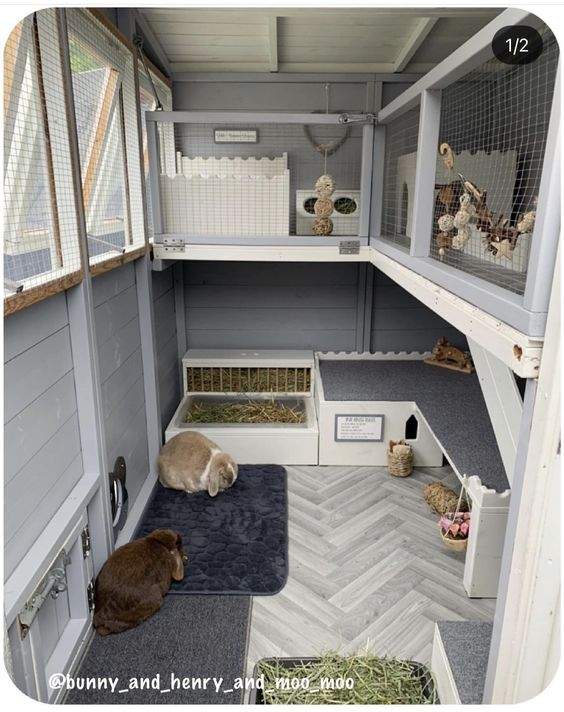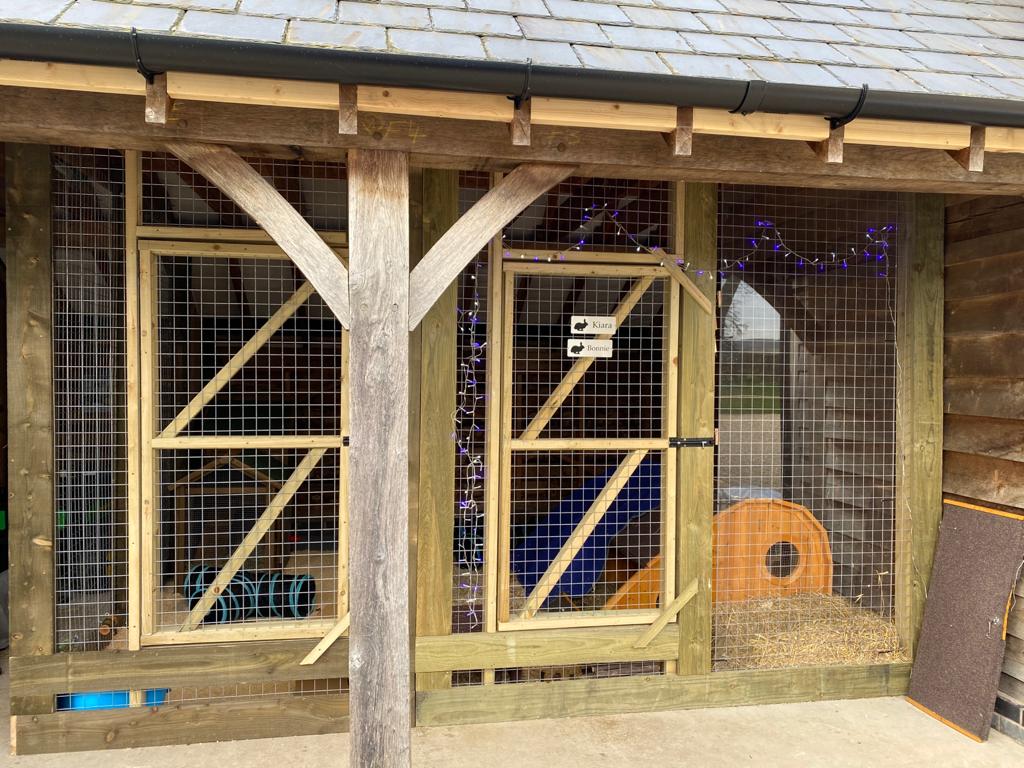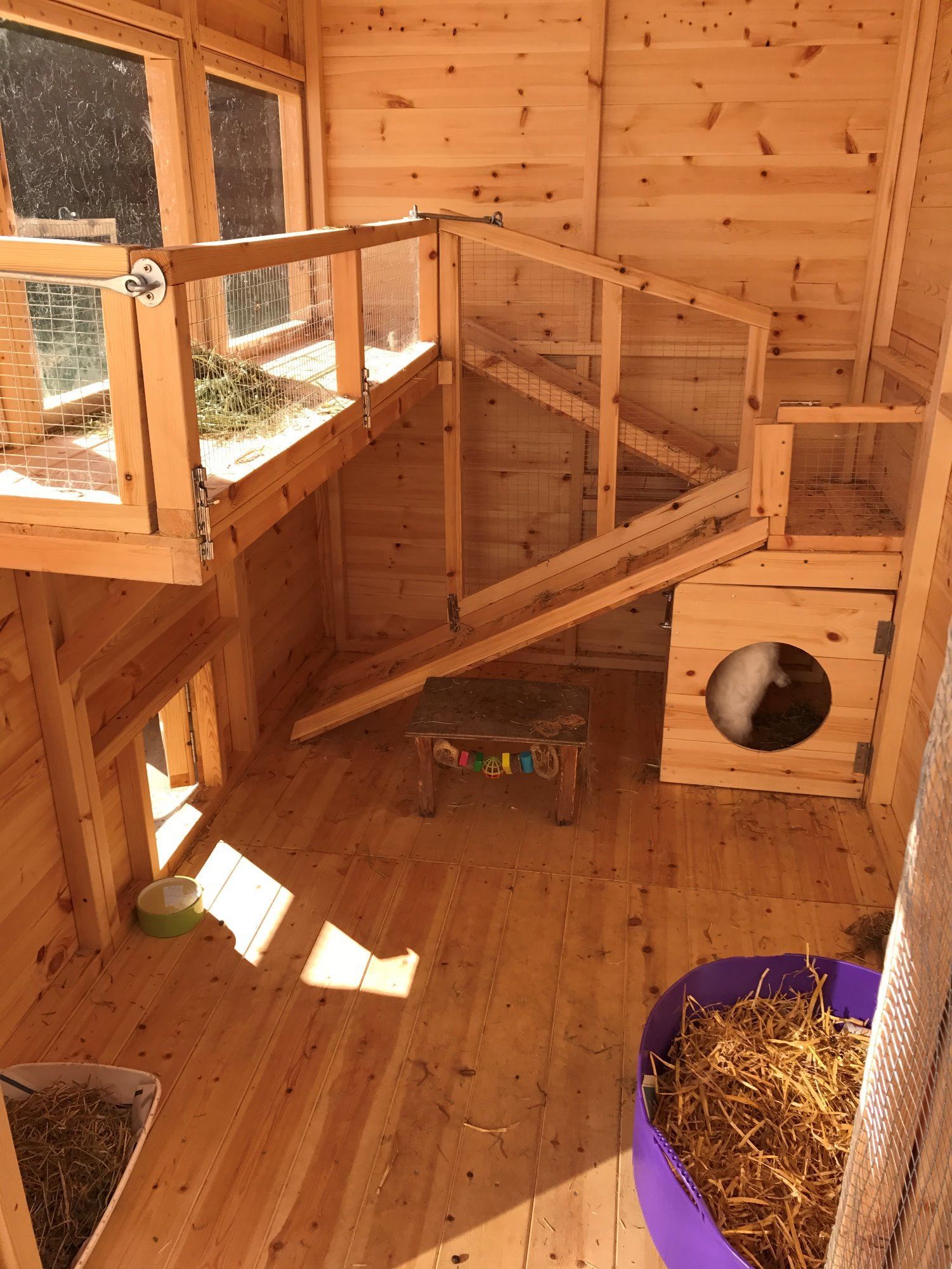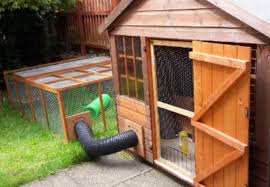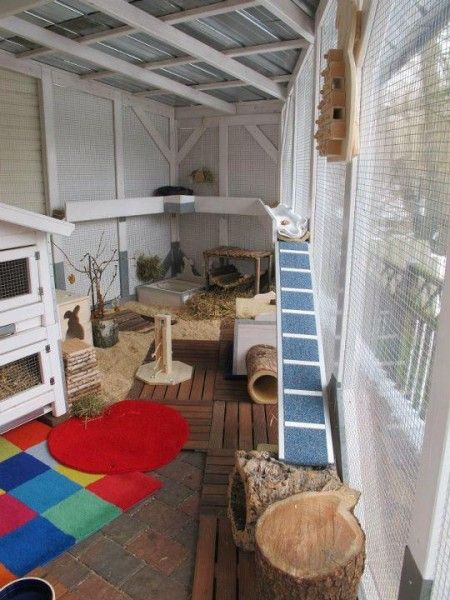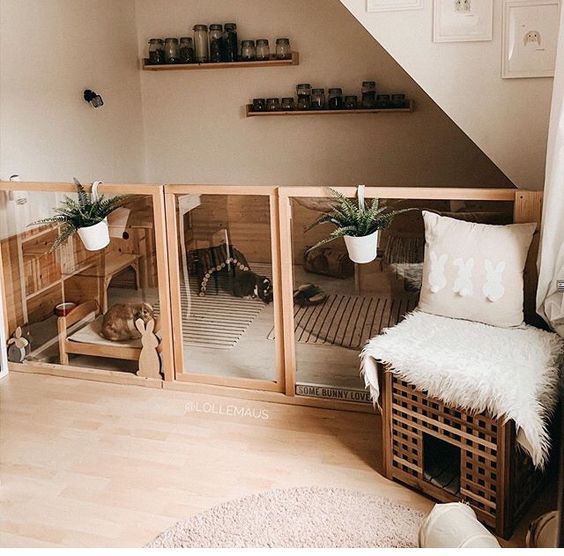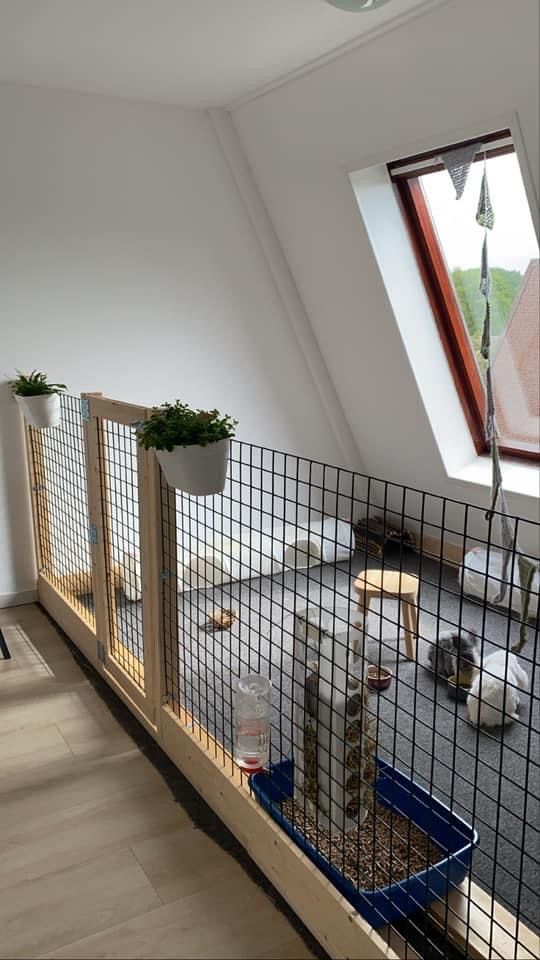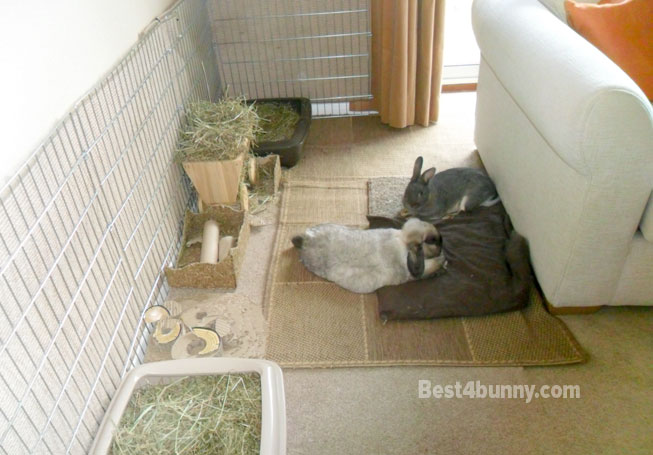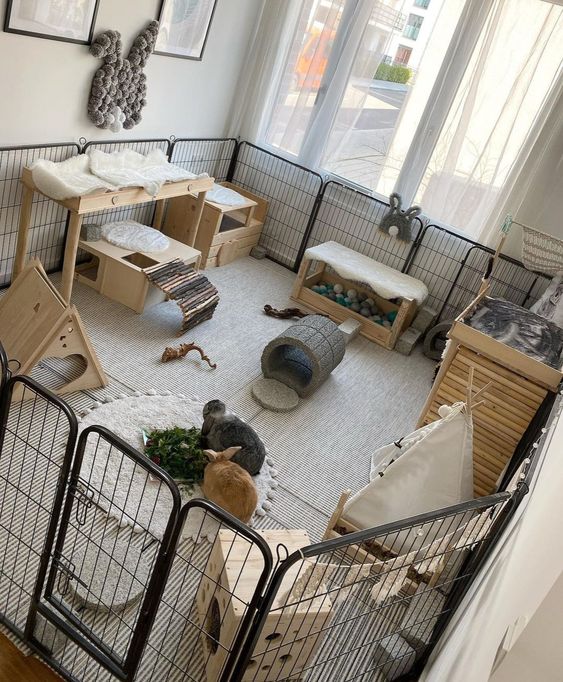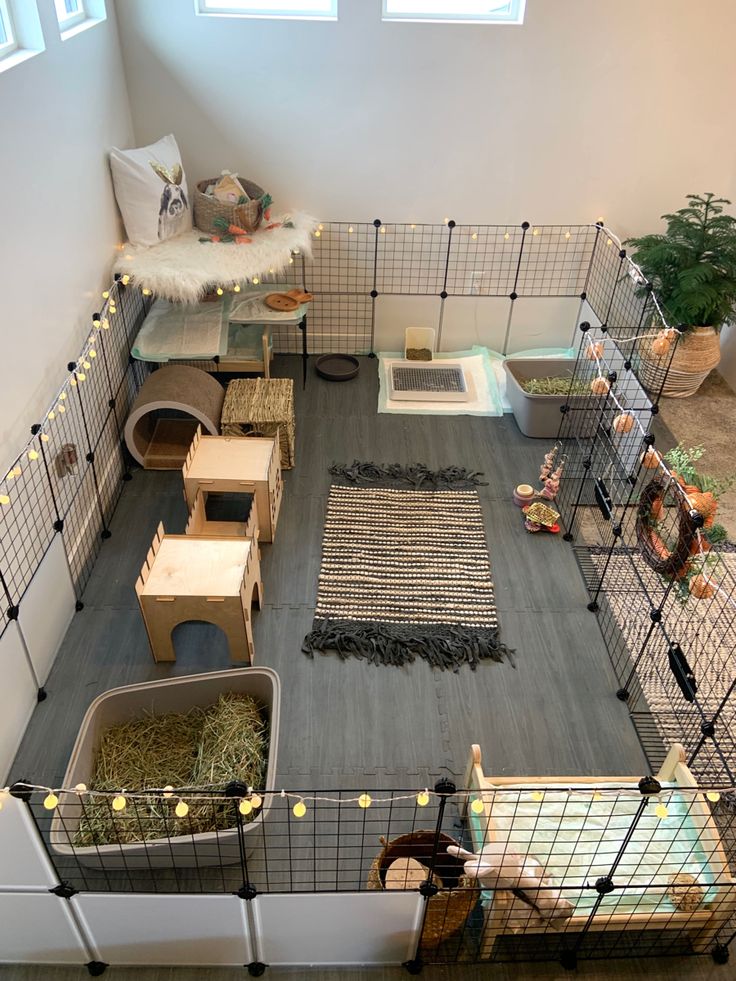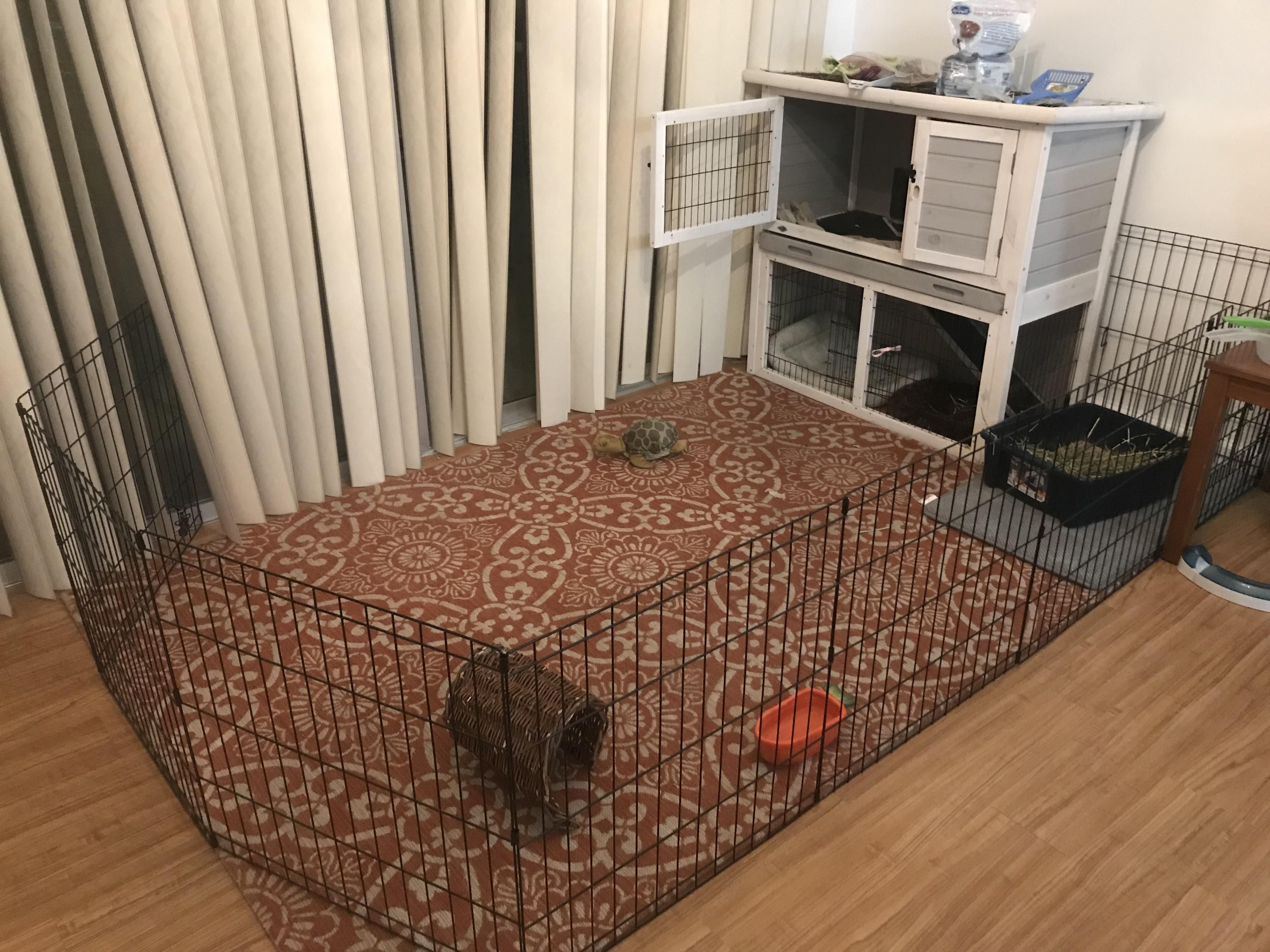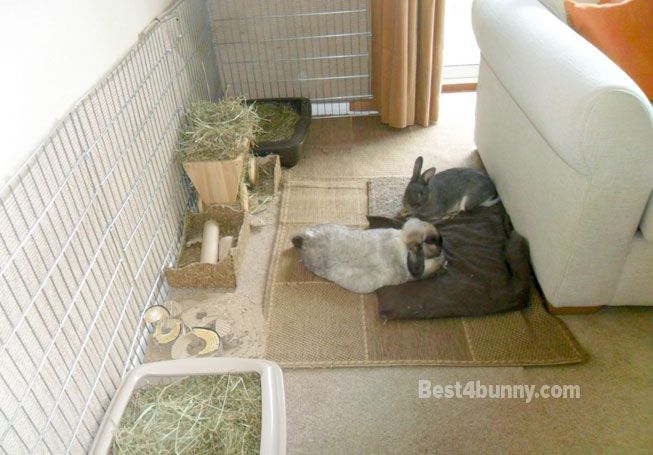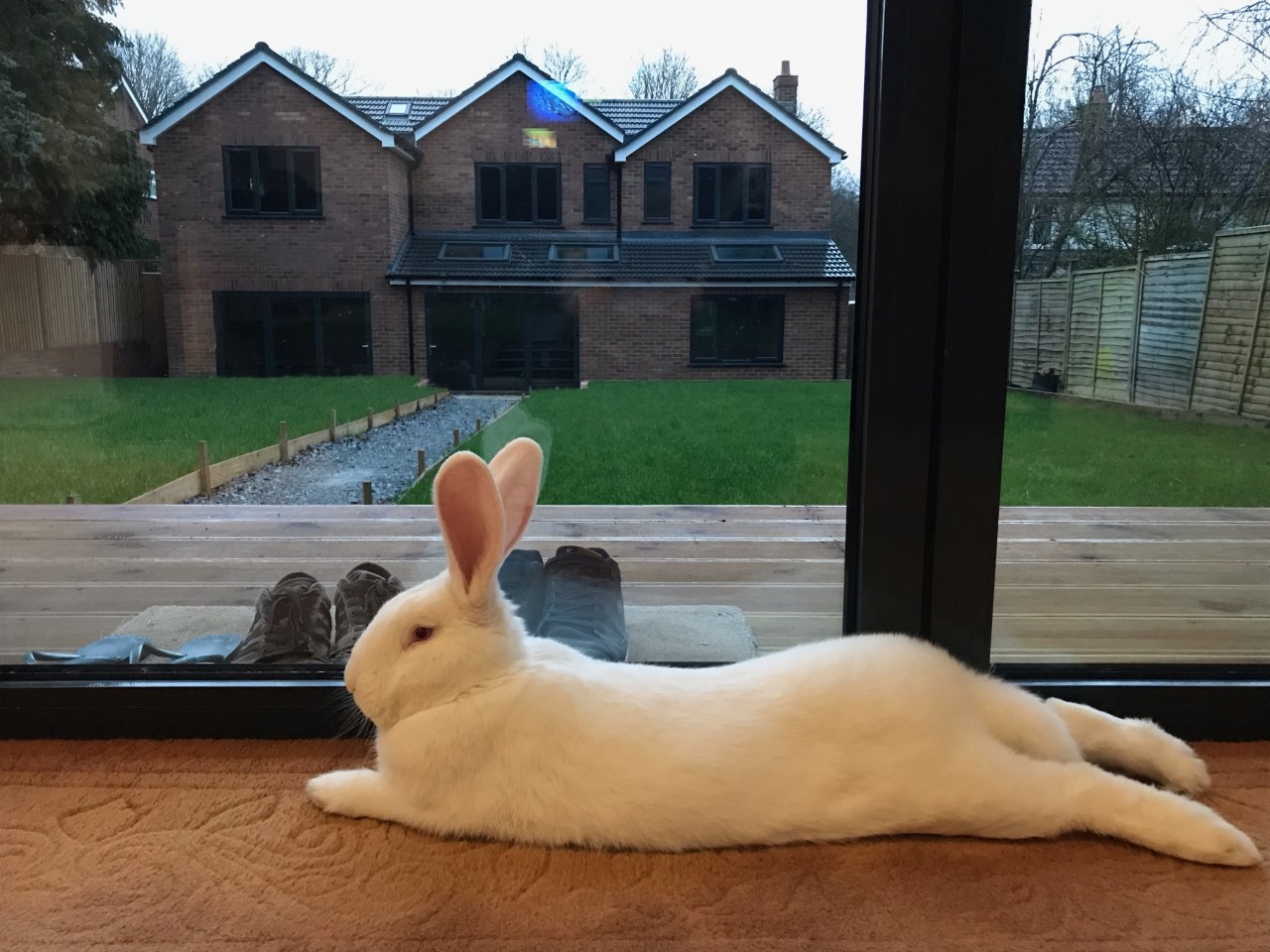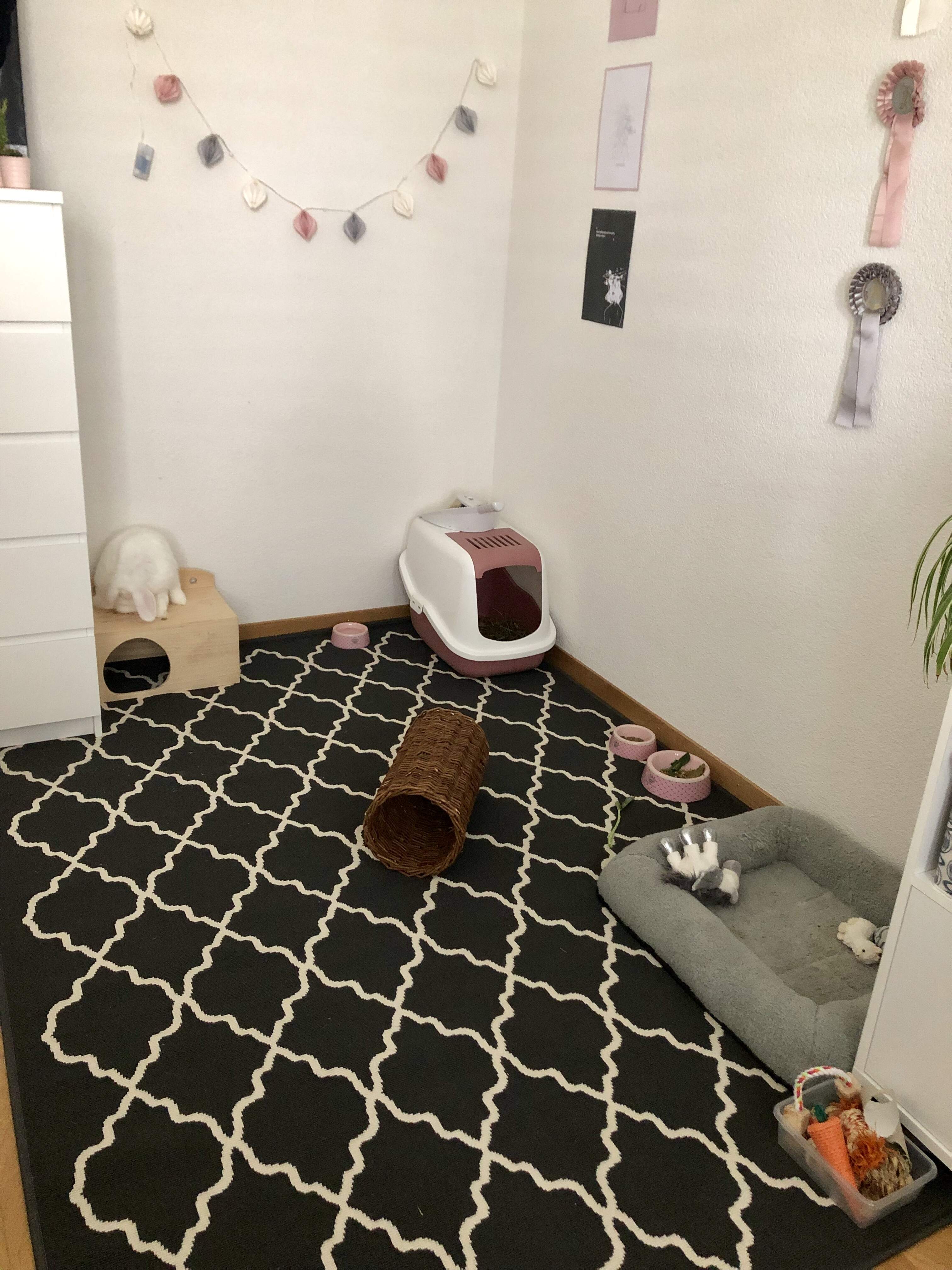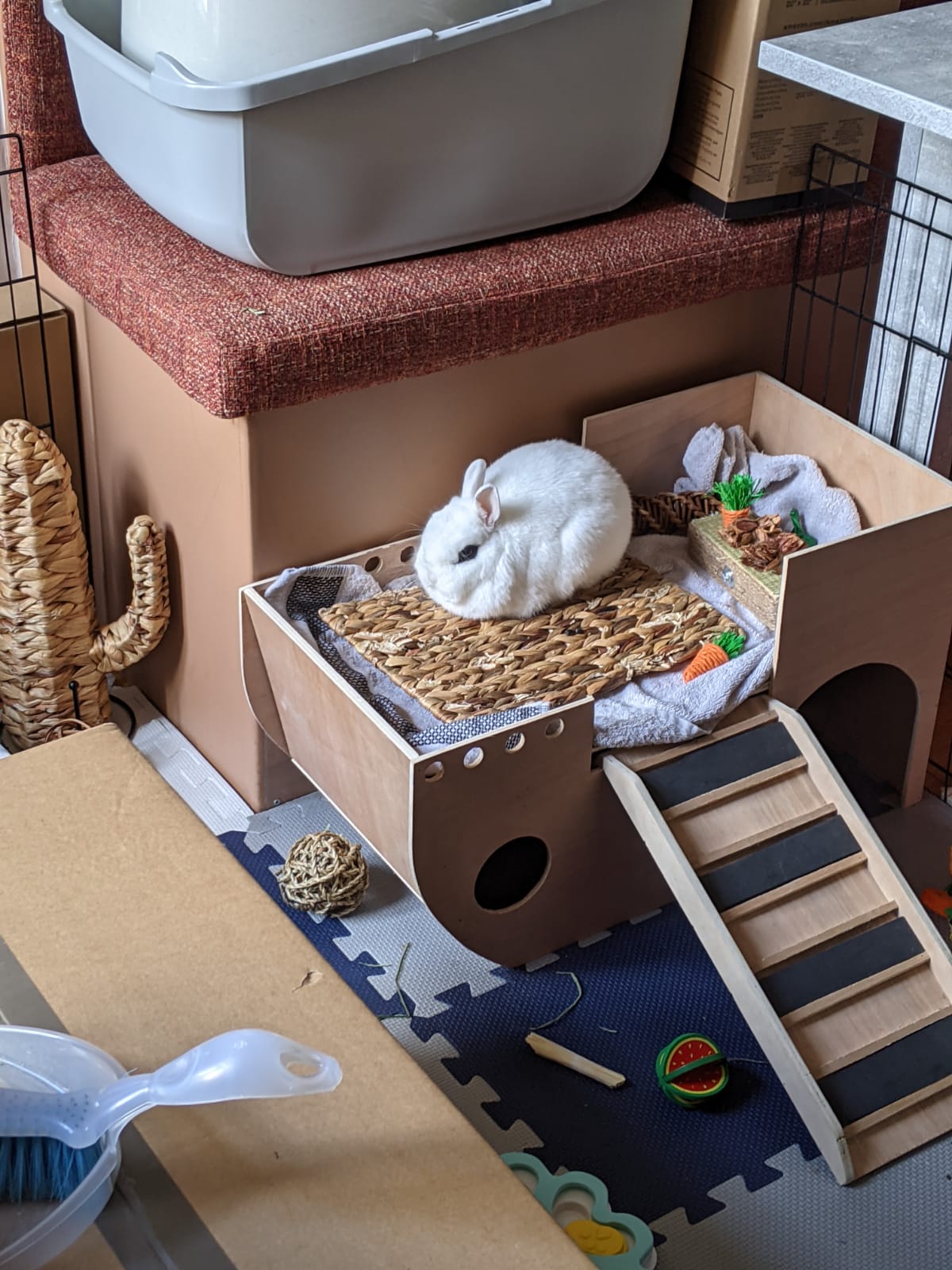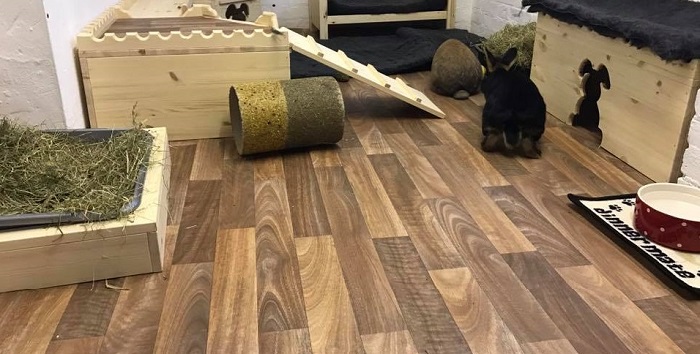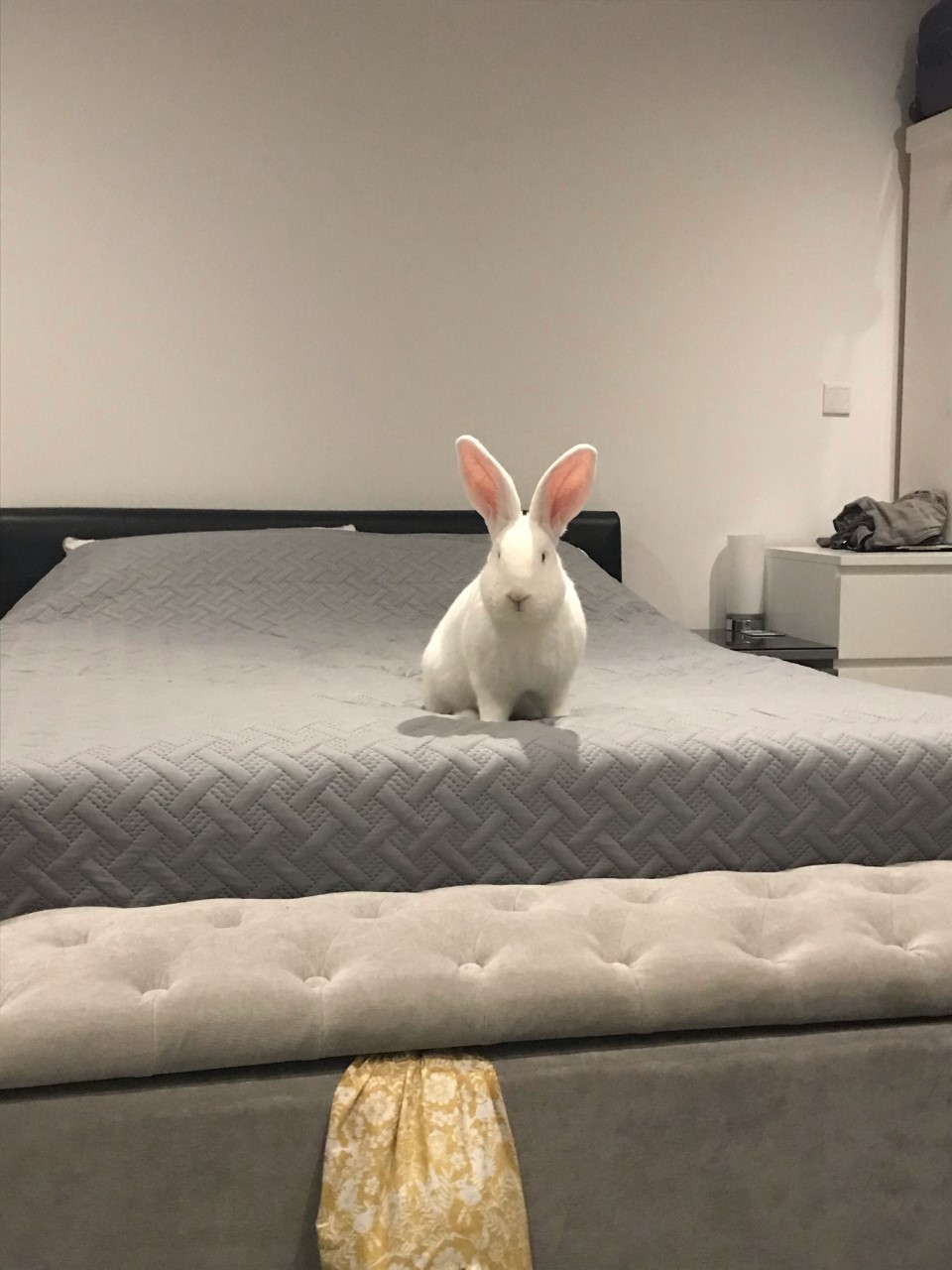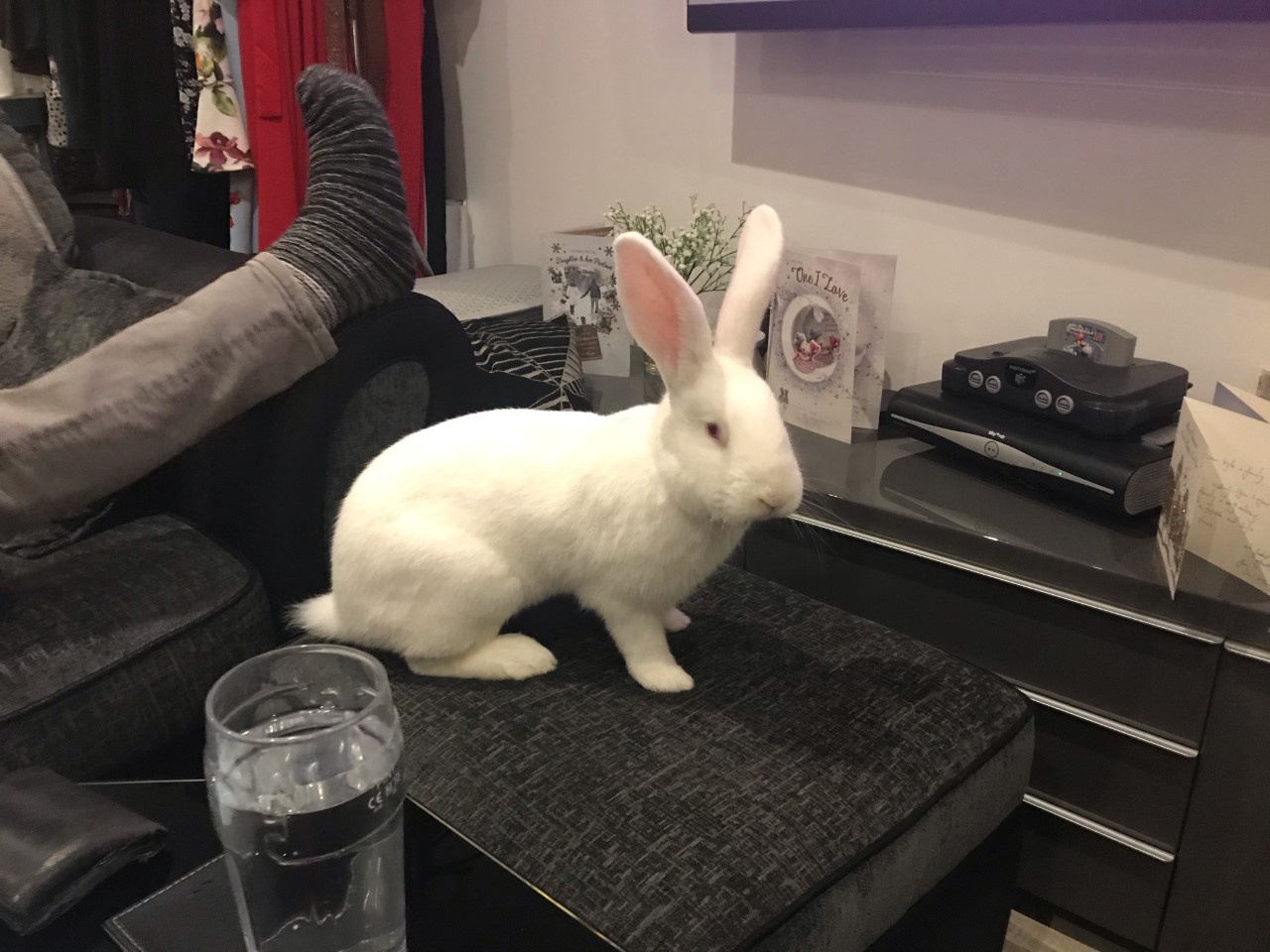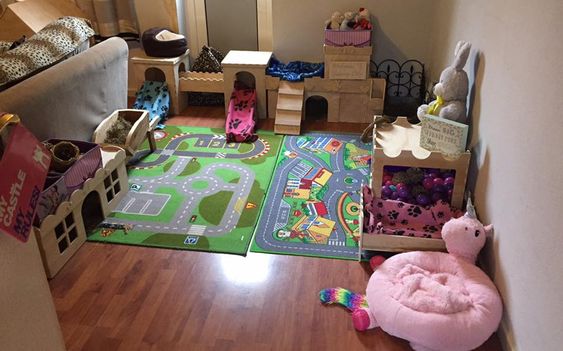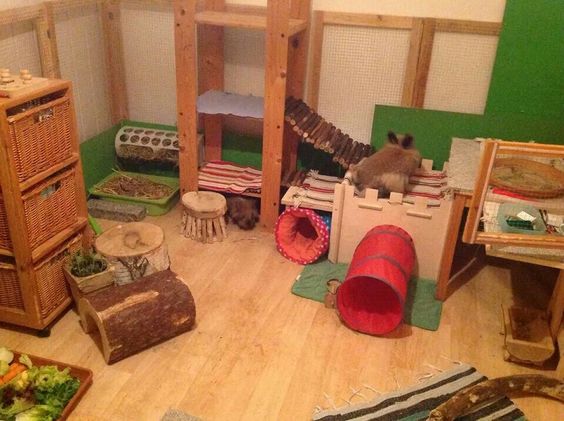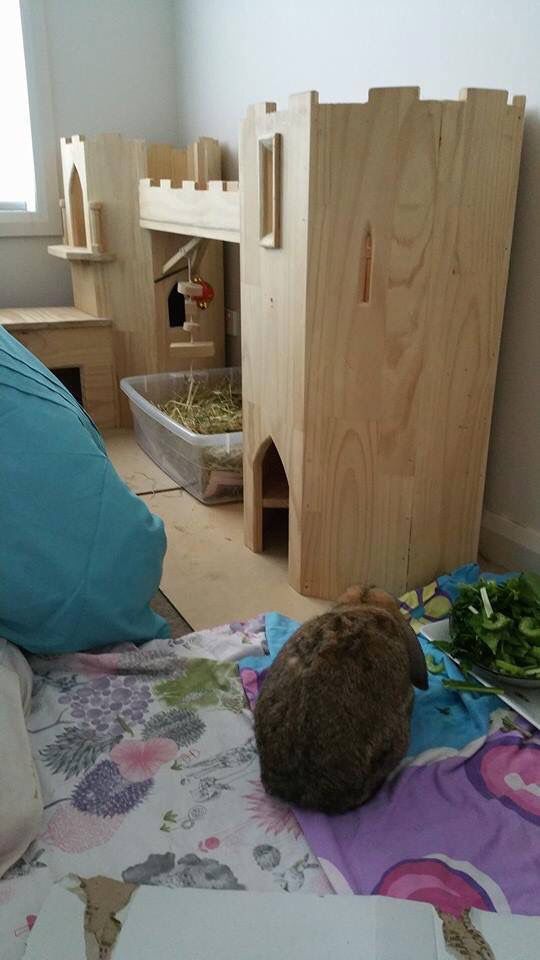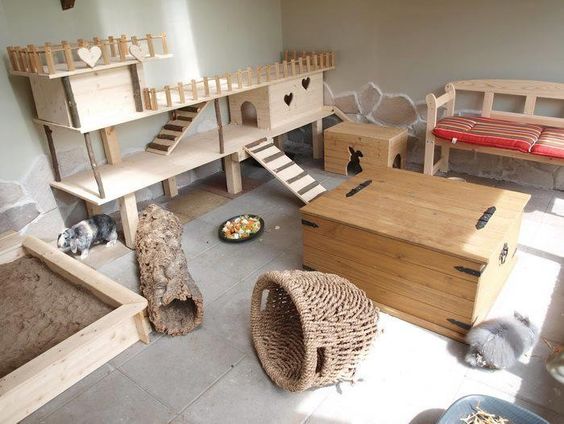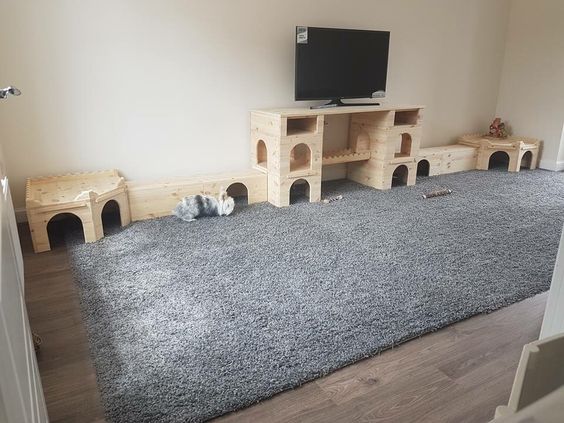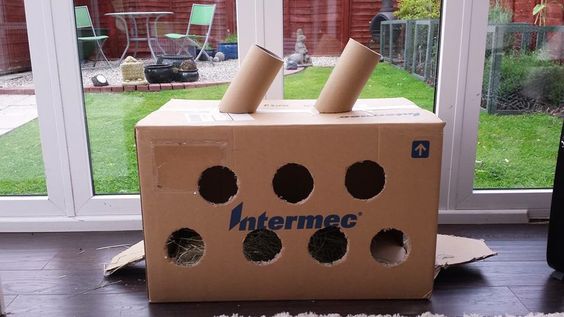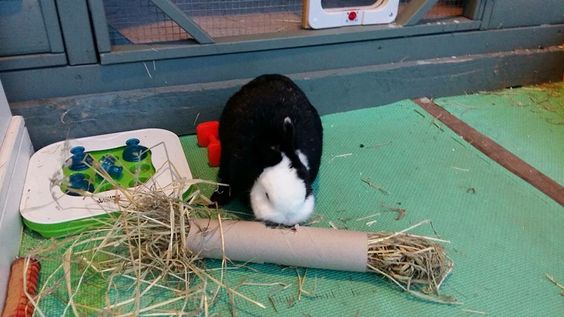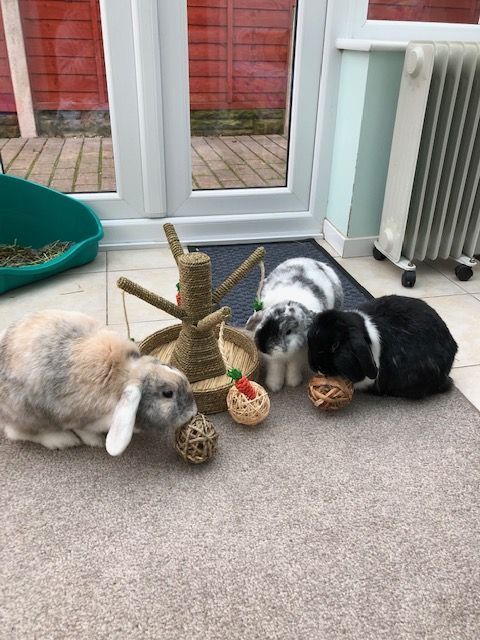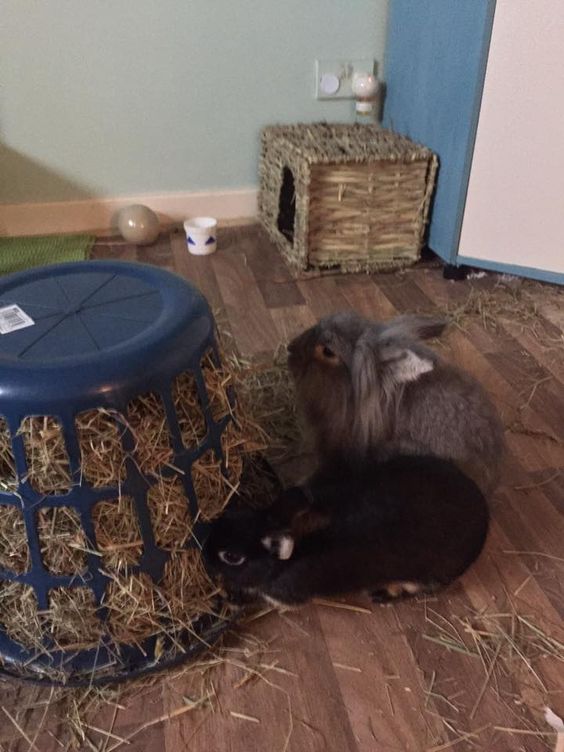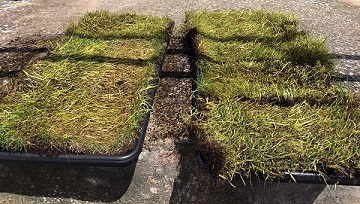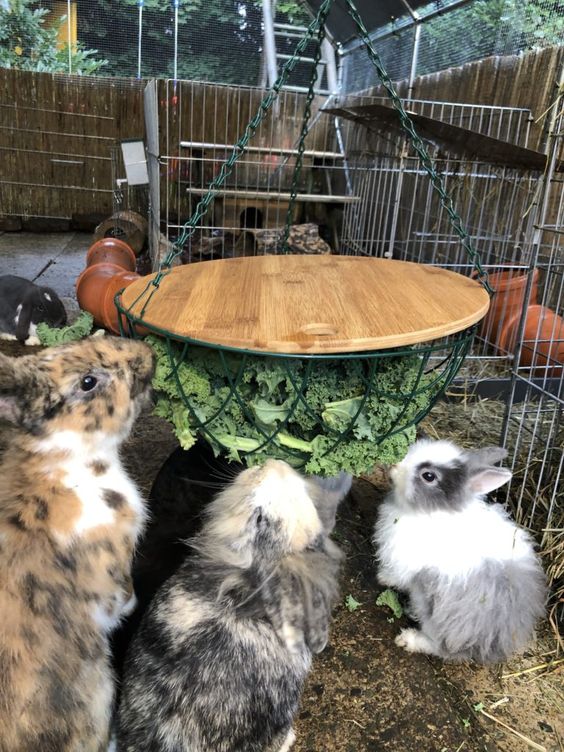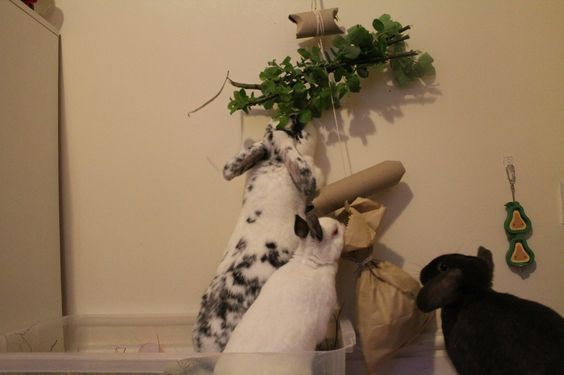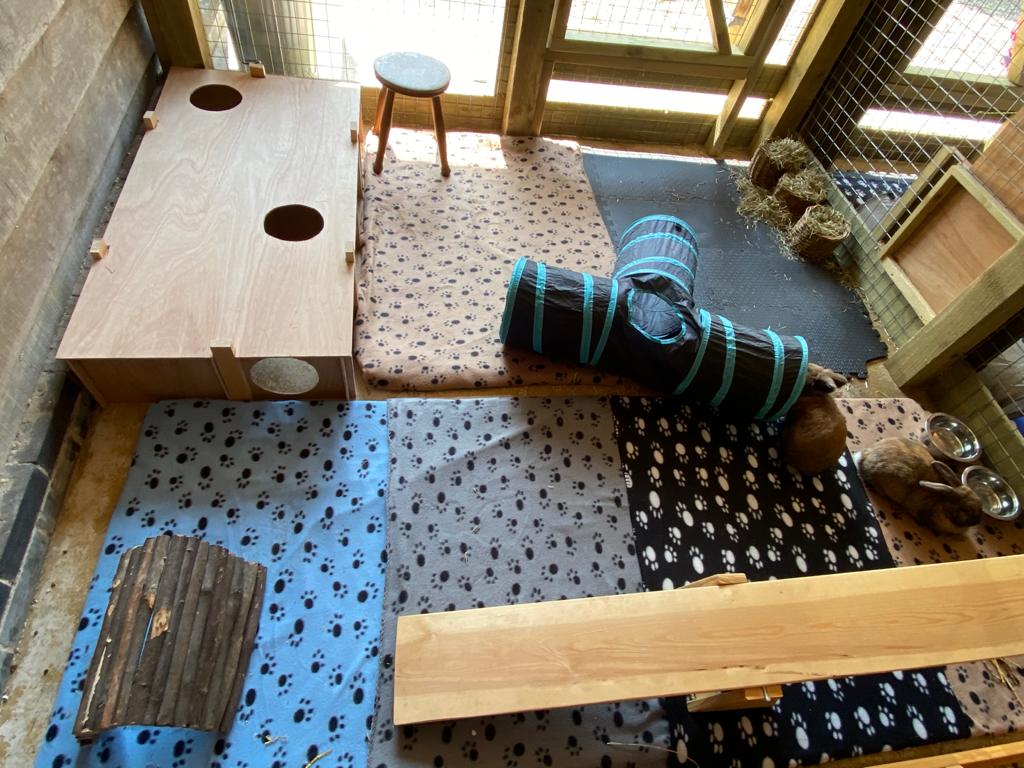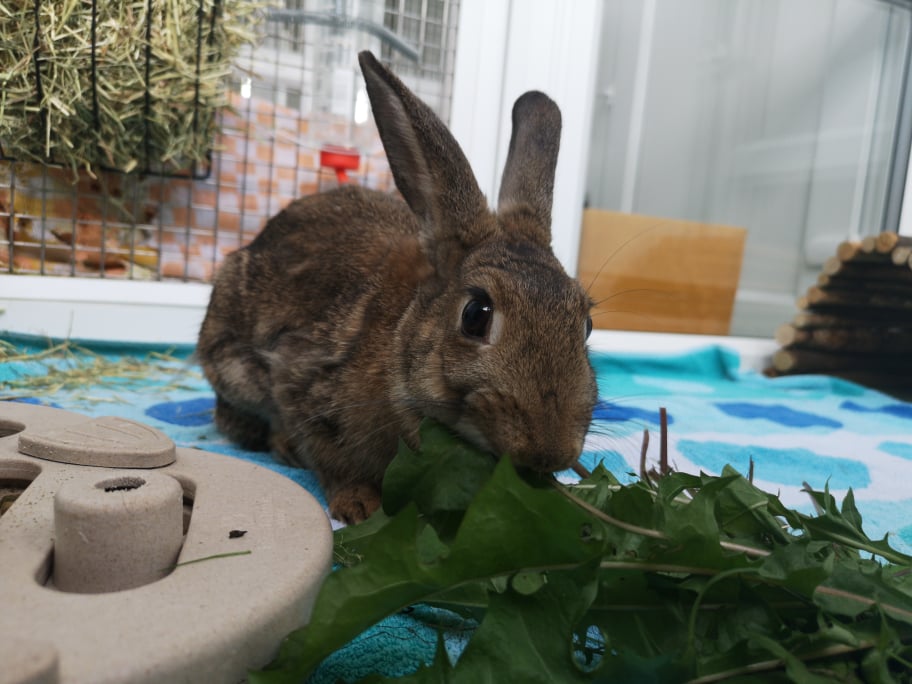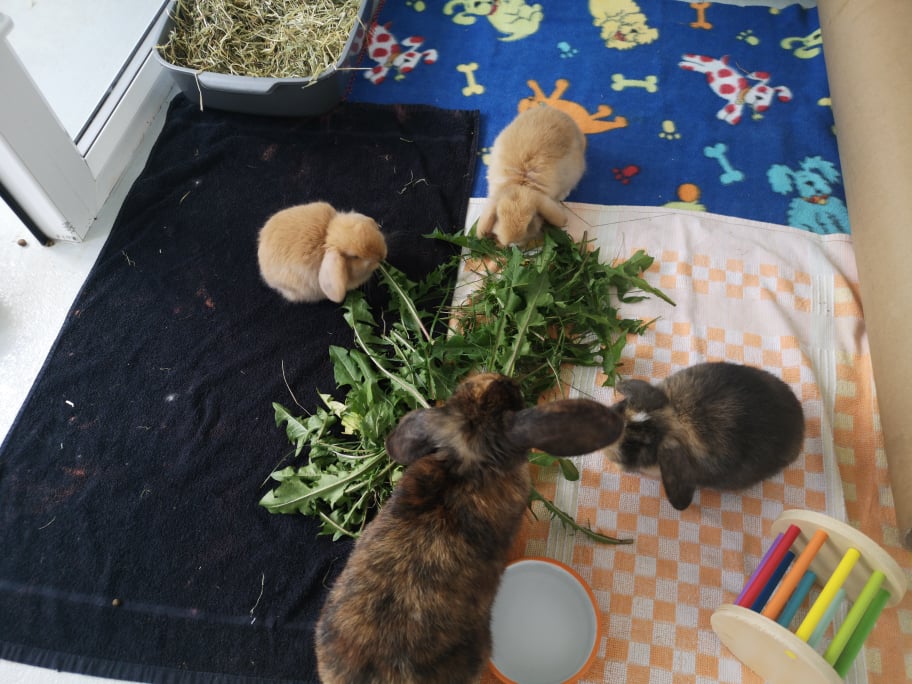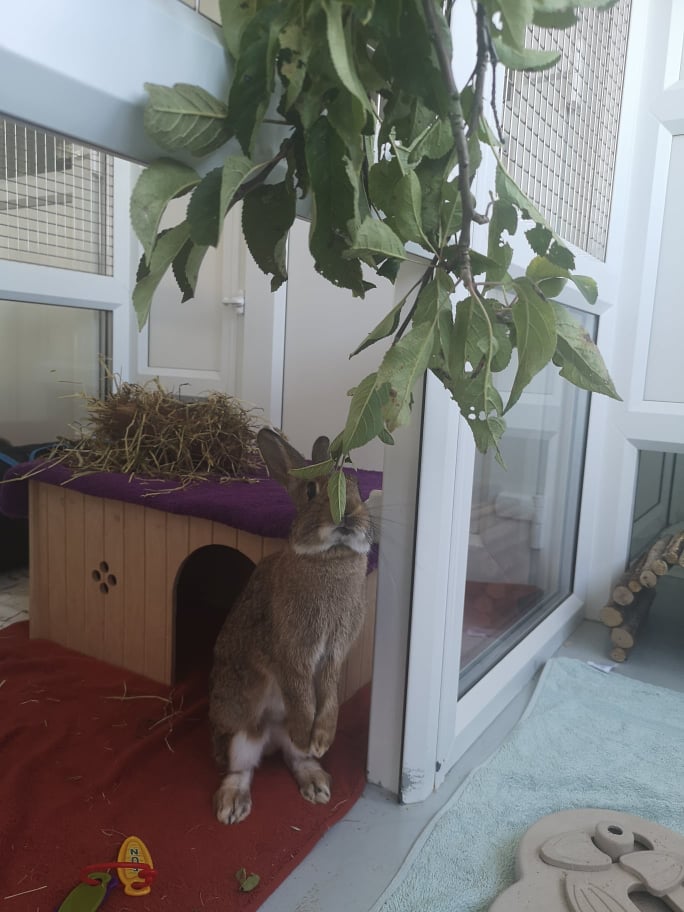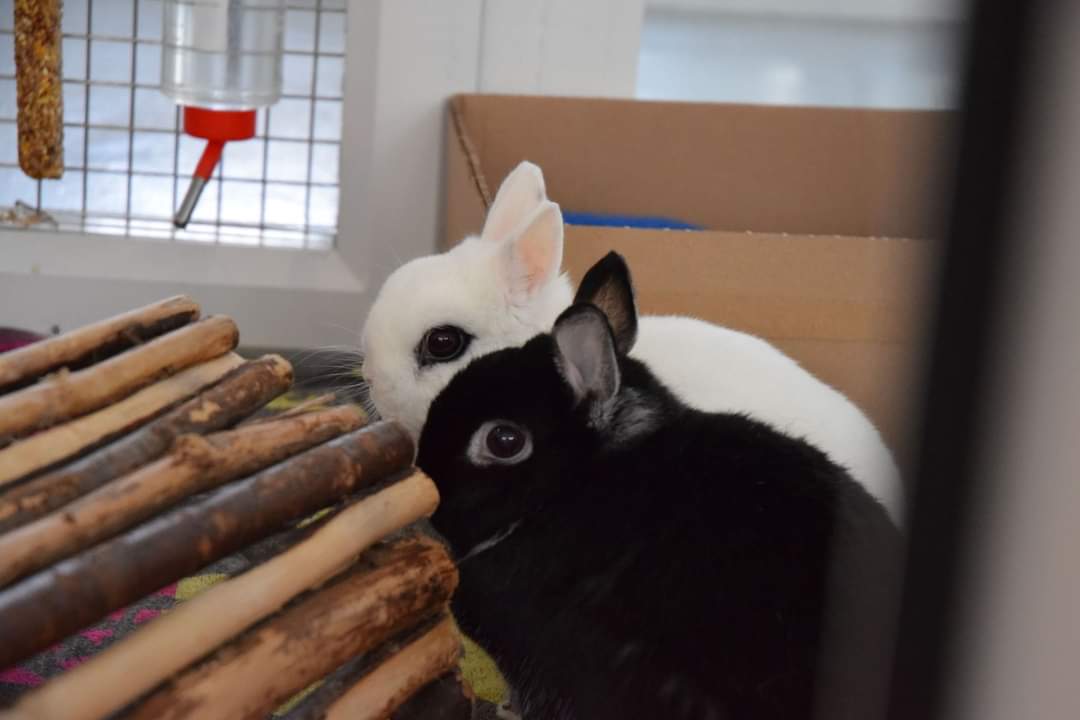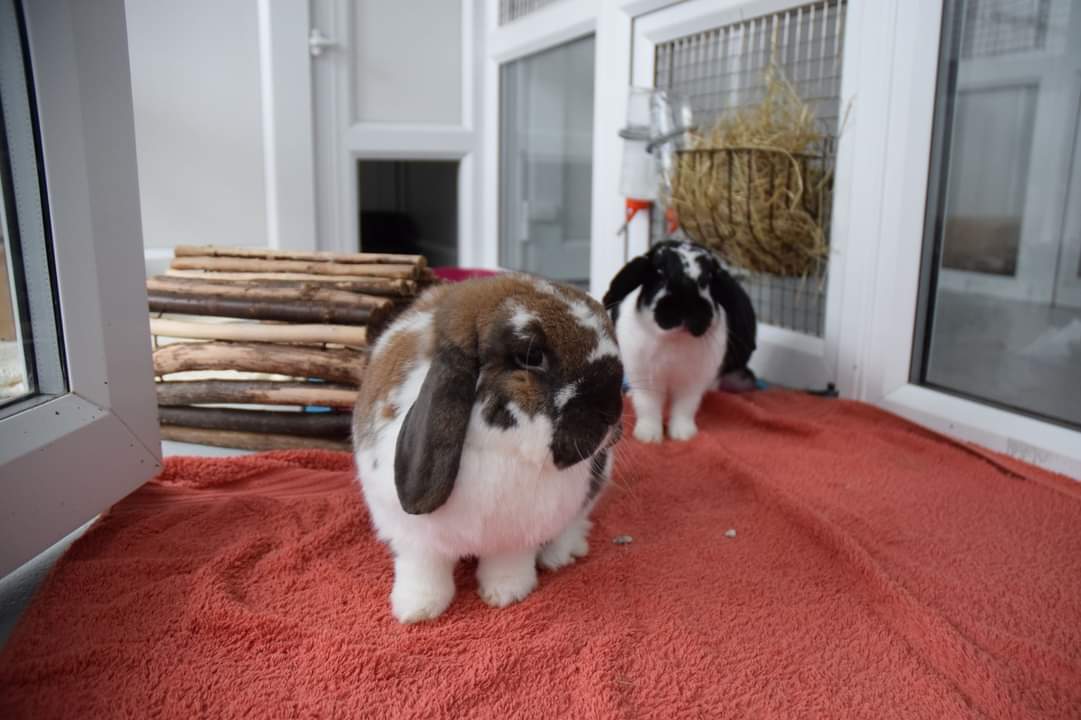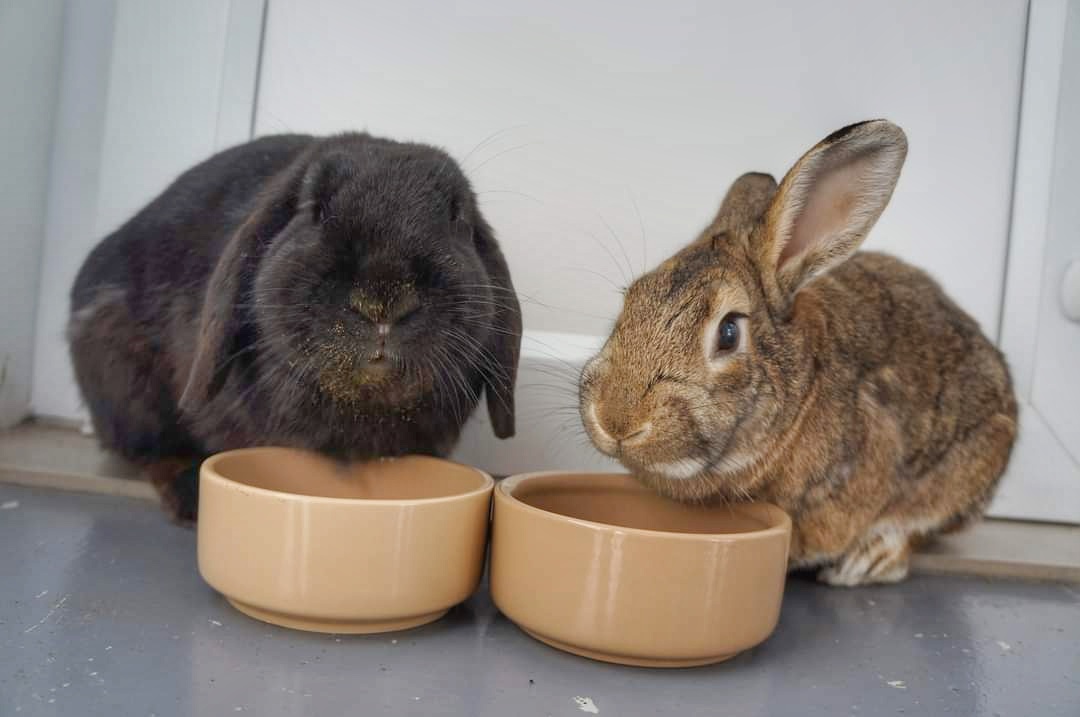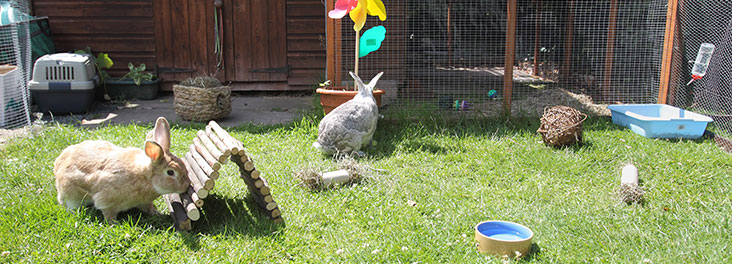If you have any questions relating to rabbit care, please be advised that we are always here to help, whether or not you are adopting from an RSPCA Branch.
For any queries you may have about caring for rabbits, please email emily@rspcaworcester.org.uk providing a contact telephone number if possible.
*Please note that we are NOT qualified to give out veterinary advice; for any concerns about your rabbit's health you should always contact your vet as soon as possible.*
PAGE INDEX
2. Outdoor Housing
3. Indoor housing (Plus tips on rabbit-proofing your home)
4. Enrichment
5. Diet
6. Litter training
7. Holiday care
8. Transportation
9. Bonding rabbits
10. Checklist
1. Minimum size requirements - A living space
Our minimum size requirements for for accommodation for two medium sized rabbits is an area of at least 3 metres by 2 metres by 1 metre high (60sqf), but remember, BIGGER is always better! Essentially, when it comes to housing rabbits there is no such thing as too much space. An RSPCA funded study at the University of Lincoln revealed that rabbits are greatly motivated to seek more space than is available in conventional housing. This means that rabbits need to be kept in a space that allows them to exhibit their normal behaviours at all times of the day and night.
For example, if you keep a rabbit in a hutch, even just overnight, you are denying them the opportunity to express fundamental behaviours such as stretching, running and jumping when they are most active (dawn and dusk). Placing a rabbit in an exercise run is no better because you are dictating when they should use the space provided. For this reason, we require a permanent run attached to a hutch.
When thinking of rabbit accommodation, you need to think about how rabbits behave in the wild.
They need 24/7 access to a safe environment that allows them to do all of the following:-
 Running
Running  Digging
Digging  Jumping
Jumping
 Hiding
Hiding  Foraging/Grazing
Foraging/Grazing
 Stretching up on their hind legs
Stretching up on their hind legs
 Lying fully stretched out
Lying fully stretched out
 Binkying
Binkying
2. Outdoor housing
The recommended minimum size already mentioned above is intended for small to medium sized rabbits; large and giant rabbits will need bigger accommodation. As a rule, a rabbit should be able to take at least three hops in a row from one end to the other.
It can be difficult to buy purpose-built accommodation measuring these dimensions but there’s no reason why you can’t build your own!
Rabbits are a prey species and need to be able to hide from things that scare them. They need to hide in secure places, away from sights and smells of predators (e.g. foxes/cats/dogs/ferrets/birds of prey). Making sure that your accommodation is escape-proof as well as fox-proof is essential!
Many people are now looking at alternative accommodation to hutches as they can be difficult to build and most of the time you will not be able to find one suitable that meets the minimum size to ensure that animal welfare standards are met. Not only is size an issue but also weatherproofing. Most hutches found online or in pet shops are made out of thin and weak materials that do not stand the test of time or our cold, wet British weather.
Shelter and run:
A hutch is NEVER enough! A run should always be permanently attached to the sleeping quarters/internal shelter with 24/7 access. Rabbits are most active in the early morning, evening and overnight. This is when they like to graze, forage for food and be sociable so every effort should be made to ensure that rabbits have access to a large exercise area at all times - lifting them from their accommodation to a run for a few hours in the daytime just doesn’t suit their body clocks and instincts.
The minimum size for rabbit accommodation is 3 metres x 2 metres x 1 metre high. The internal shelter should be a minimum of 1.8m x 0.9m x 0.9m high (or 6ft x 3ft x 3ft) and permanently attached to a larger area. Sadly most hutches and runs that are available online are just not big enough - be savvy; just because it is for sale doesn’t mean it is suitable! The minimum for internal shelters is the size of the enclosed area where weather cannot get in, most hutches found online unfortunately have most of the shelter exposed to the UK weather via wire mesh and therefore not suitable.
Converted shed and run:
Converting a shed, Wendy house or summerhouse into a bunny paradise is getting more and more popular, especially now that more people are realising that our rabbits need access to bigger spaces to be able to carry out the simplest of behaviours like running and jumping. Not only do sheds offer more room for your furry friends but they are also easy to insulate for the colder weather and last much longer than a hutch; as well as giving the owners the option to go inside making it easier to clean and interact with the bunnies. Runs can be easily attached to the side of a shed with access via a hole, tunnel or cat-flap.
Below are some examples of ideal outdoor rabbit housing.
3. Indoor housing
Are you able to 'rabbit-proof' your home? - Please see below for tips on how to rabbit-proof your home.
House bunnies are starting to get more and more popular and they can make wonderful indoor pets, but before rushing into it please consider the following; Where in your home are you going to keep your bunnies? - Will they get disturbed by loud appliances like TVs or will they be housed next to a draught?
Where in your home are you going to keep your bunnies? - Will they get disturbed by loud appliances like TVs or will they be housed next to a draught?
 Do you have enough room? - Indoor rabbits need the same amount of space as outdoor rabbits.
Do you have enough room? - Indoor rabbits need the same amount of space as outdoor rabbits.
 Will they still have access to an area outdoors? - It is important to give your rabbits access outside to fulfil natural behaviours.
Will they still have access to an area outdoors? - It is important to give your rabbits access outside to fulfil natural behaviours. Is your home 'rabbit safe'? - Other pets, house plants and electric wires can all pose a risk to your rabbit's safety.
Is your home 'rabbit safe'? - Other pets, house plants and electric wires can all pose a risk to your rabbit's safety.
Options for keeping house rabbits:
Free roaming: As the name suggests, this is where the rabbits are given the run of most, if not all, of the house. If you choose this option, we recommended starting off in one room or part of a room to begin with while your rabbits settle in and get used to both you and their new environment. Once they have settled into their new home and they are fully litter trained you can start letting them out to explore the rest of your (and their!) home.See the ‘litter training’ and 'tips for rabbit proofing your home' below for more information and advice.
A particular room: This tends to be a room that has a hard surface where it is easier for you to clean up any toilet accidents or old food. Rabbits have fur on their feet and can't grip hard surfaces very well without slipping and sliding so it is essential to put something in place for them to hop onto. This can be anything from blankets, towels, rugs, carpet squares or cut-offs. Soft playmats are often used but please monitor your rabbits very closely in the first few weeks of using mats to make sure they do not chew and ingest any pieces. To prevent this make sure to give them plenty of room and chewable enrichment for them to nibble instead.
Part of a room: If you want your rabbits inside but can't give them an entire room, you can use large runs, flexi pens or CMC caging to cordon off part of a room. As long as you follow our minimum standard on size, you can have this as a permanent option for your rabbits or if you want to keep them a bit more secure when you are not at home and monitoring them.
Tips for rabbit proofing your home:
 Rabbits love to chew so it's important to make sure you protect your furniture and make your home safe for our bunnies. You can protect furniture with guards, covers, and boxing. If you are not able to use these then getting flexi pens or some type of caging to protect your possessions could be a good option. Every rabbit is different, some will chew more than others, so it is important to make sure you have plenty of enrichment in your home to keep your rabbit entertained so they don't get too tempted to start chewing something you don't want chewed!
Rabbits love to chew so it's important to make sure you protect your furniture and make your home safe for our bunnies. You can protect furniture with guards, covers, and boxing. If you are not able to use these then getting flexi pens or some type of caging to protect your possessions could be a good option. Every rabbit is different, some will chew more than others, so it is important to make sure you have plenty of enrichment in your home to keep your rabbit entertained so they don't get too tempted to start chewing something you don't want chewed!
 Cables and wires are very tempting to your rabbit; make sure they are all out of reach by covering them with cable boxes or putting caging around areas like computers or the back of your TV to keep them out of nibbling reach!
Cables and wires are very tempting to your rabbit; make sure they are all out of reach by covering them with cable boxes or putting caging around areas like computers or the back of your TV to keep them out of nibbling reach!
 One of a rabbit's natural behaviours is to dig. You can protect your flooring by putting down carpet squares or carpet cut-offs and by giving your rabbits enrichment boxes and digging trays. Please see 'Enrichment' below for further information on these.
One of a rabbit's natural behaviours is to dig. You can protect your flooring by putting down carpet squares or carpet cut-offs and by giving your rabbits enrichment boxes and digging trays. Please see 'Enrichment' below for further information on these.
 Rabbits have furry feet so any hard surfaces in your home can be very slippery for them. By placing towels, blankets, rugs, carpet squares or matting down for your rabbits to run on, or to hop from one to another like islands, can help prevent your home from being a dangerous slip and slide.
Rabbits have furry feet so any hard surfaces in your home can be very slippery for them. By placing towels, blankets, rugs, carpet squares or matting down for your rabbits to run on, or to hop from one to another like islands, can help prevent your home from being a dangerous slip and slide.
 Use caging like flexi pens or CMC caging to block off areas you don’t want them to hide in. Rabbits are very inquisitive animals and will squeeze their way into every gap to explore if you give them a chance. To fill this need, change enrichment items over every now again and bring in new toys and items for them to play with. Cardboard boxes are always a big hit with rabbits. You can attach multiple boxes together for them to climb on, and cut lots of holes for them to go through and hide in.
Use caging like flexi pens or CMC caging to block off areas you don’t want them to hide in. Rabbits are very inquisitive animals and will squeeze their way into every gap to explore if you give them a chance. To fill this need, change enrichment items over every now again and bring in new toys and items for them to play with. Cardboard boxes are always a big hit with rabbits. You can attach multiple boxes together for them to climb on, and cut lots of holes for them to go through and hide in.
 Keep anything that could potentially harm them well out of reach. Normal household items like house plants can pose a risk to your rabbits so make sure you do your research by Googling 'is this plant safe for rabbits?' and keep them well out of reach.
Keep anything that could potentially harm them well out of reach. Normal household items like house plants can pose a risk to your rabbits so make sure you do your research by Googling 'is this plant safe for rabbits?' and keep them well out of reach.
 If you don't want your bunnies to access a certain room or upstairs then you can use stair gates with wire mesh attached.
If you don't want your bunnies to access a certain room or upstairs then you can use stair gates with wire mesh attached.
 Rabbits are great escape artists so be very careful every time you go to go outside or when you enter your home. Even an open window is very tempting. Rabbits love to jump so be careful about tucking your chairs in, in order to prevent your rabbits getting onto tables where they can potentially get out of a window.
Rabbits are great escape artists so be very careful every time you go to go outside or when you enter your home. Even an open window is very tempting. Rabbits love to jump so be careful about tucking your chairs in, in order to prevent your rabbits getting onto tables where they can potentially get out of a window.
 Be careful when leaving any items in the path of your rabbits; everything is a tempting chew toy so closely monitor your rabbits with anything new to prevent them from ingesting something they shouldn't.
Be careful when leaving any items in the path of your rabbits; everything is a tempting chew toy so closely monitor your rabbits with anything new to prevent them from ingesting something they shouldn't.
 Something as simple as watching TV or vacuuming can be very scary for any new bunny so be sure to help your rabbits adjust to any new smells or noises in your home.
Something as simple as watching TV or vacuuming can be very scary for any new bunny so be sure to help your rabbits adjust to any new smells or noises in your home.
4. Enrichment
Running, hopping and rearing up :
Digging :
 Outside rabbits - If you house your rabbits outside you can use slabs to create a digging pit by digging a hole, placing slabs down to create a 'swimming pool' looking pit and then filling it with safe soil. This is to prevent your rabbits from digging out of their accommodation and escaping.
Outside rabbits - If you house your rabbits outside you can use slabs to create a digging pit by digging a hole, placing slabs down to create a 'swimming pool' looking pit and then filling it with safe soil. This is to prevent your rabbits from digging out of their accommodation and escaping.  Indoor rabbits - If your rabbits don't have access outside then you will need to provide an indoor solution. Using large, covered cat litter trays filled with safe soil is a great way to keep the soil contained within the tray and avoid any unnecessary cleaning. Make sure to change the soil regularly to prevent toileting build up.
Indoor rabbits - If your rabbits don't have access outside then you will need to provide an indoor solution. Using large, covered cat litter trays filled with safe soil is a great way to keep the soil contained within the tray and avoid any unnecessary cleaning. Make sure to change the soil regularly to prevent toileting build up.Foraging and Eating :
Rabbits love to snuffle around and forage for food. Rather than using a bowl for their nuggets or fresh food, try hiding the food around the enclosure, in tunnels and in/on hides to get their noses working. This will encourage them to forage for their food and prevent boredom and obesity. You can also try;
 Treat balls for them to push around to get the pellets or treats out.
Treat balls for them to push around to get the pellets or treats out. Toilet roll tubes, willow tunnels, egg boxes, paper bags or cardboard boxes stuffed with hay and fresh food for them to break their way into.
Toilet roll tubes, willow tunnels, egg boxes, paper bags or cardboard boxes stuffed with hay and fresh food for them to break their way into.  Stringing up willow, hazel, apple and blackthorn branches for them to reach up for. These are a healthy and natural treat that you may be able to find in your garden for free and are always a big hit with rabbits.
Stringing up willow, hazel, apple and blackthorn branches for them to reach up for. These are a healthy and natural treat that you may be able to find in your garden for free and are always a big hit with rabbits.  Hiding treats or nuggets in snuffle-mats that you can either buy or make out of old, clean rags.
Hiding treats or nuggets in snuffle-mats that you can either buy or make out of old, clean rags.  Dog puzzle feeders are a great boredom buster and prevent your rabbit from eating all of their nuggets too fast - making them work for their meal. You can start at the beginner's level and work your way up.
Dog puzzle feeders are a great boredom buster and prevent your rabbit from eating all of their nuggets too fast - making them work for their meal. You can start at the beginner's level and work your way up.  If your rabbits don't have access outside, you can make a turf box by filling a cat litter tray or a plastic dog bed with some turf either from your garden or from your local garden centre. This will allow them to nibble on some fresh grass. It may be a good idea to have two so that once they have eaten all the grass in one tray, you can give them the second to allow the first to regrow.
If your rabbits don't have access outside, you can make a turf box by filling a cat litter tray or a plastic dog bed with some turf either from your garden or from your local garden centre. This will allow them to nibble on some fresh grass. It may be a good idea to have two so that once they have eaten all the grass in one tray, you can give them the second to allow the first to regrow. Hiding :
Rabbits are prey animals so to ensure they feel safe in their home, make sure you provide enough hiding places for them to nip in and out of. You can provide hiding places by using tunnels, stools and cardboard boxes. Tunnels are very important as this provides a substitute burrow and encourages your rabbit to be more active! You don't necessarily need to buy tunnels; using cardboard boxes from your last online shopping spree is all you need! Simply get one cardboard box and cut an entrance and exit or gather multiple boxes of different sizes and DIY them together to make an interesting tunnel network or maze for your rabbits to explore and have fun.
Socialising:
Rabbits are highly social animals and need to have the companionship in the form of another rabbit (rabbits can live in pairs or groups).
No matter how much time we spend with our bunnies, nothing matches the company of another rabbit. We lead busy lives and even if we make sure to spend four hours a day with our rabbits, the other twenty hours they are alone.. but if they live with another rabbit, they will never be lonely!
Not only does living with another bunny prevent them from feeling isolated, it always makes them feel safer. In the wild rabbits will live in groups called warrens, where they can snuggle up and keep each other warm and most importantly, this helps keep them safe from predators.
If a single rabbit is alone it can make them anxious, stressed and overwhelmed however, if they have company, that's another set of eyes to watch out for any potential danger, so that a single bunny doesn't have to be alert 24/7.
Extra things you can do to keep your rabbits happy (and healthy) :
 As stated above, rabbits are prey animals. As prey animals, they like to be able to check out their surroundings. Making sure your accommodation is secure from any predators is essential. In a nice, secure environment you can provide your rabbits with little extras to make them feel safer. Platforms are great enrichment items for rabbits; not only does it allow them to perch on top and scan their environment, it is also an extra toy for them to jump up onto and explore. You can DIY your own platform (see pictures below) or simply use cat trees which you can buy in most pet shops or online websites.
As stated above, rabbits are prey animals. As prey animals, they like to be able to check out their surroundings. Making sure your accommodation is secure from any predators is essential. In a nice, secure environment you can provide your rabbits with little extras to make them feel safer. Platforms are great enrichment items for rabbits; not only does it allow them to perch on top and scan their environment, it is also an extra toy for them to jump up onto and explore. You can DIY your own platform (see pictures below) or simply use cat trees which you can buy in most pet shops or online websites.
 Try not to give them every toy all at once. Switch toys and furniture around every now and again, so your bunnies don’t get bored.
Try not to give them every toy all at once. Switch toys and furniture around every now and again, so your bunnies don’t get bored. Treats from pet shops can be very unhealthy for your rabbits; instead try making your own treats by using their hay, nuggets and fresh food. See the bottom of the page for links to recipes to make your own rabbit treats.
Treats from pet shops can be very unhealthy for your rabbits; instead try making your own treats by using their hay, nuggets and fresh food. See the bottom of the page for links to recipes to make your own rabbit treats. Diet
Fresh food can be a fun and inexpensive way of feeding your furry friends and can all be found or grown in your garden!
Hay:
Fresh grass is preferable, but hay is a very good substitute and it’s available all year round. Hay should make up 85% of a rabbits diet, so it is essential to make sure they have a constant supply of fresh hay 24/7. Not only is hay important for providing vital nutrients, it also has other benefits including keeping their teeth and gut healthy. Rabbits' teeth grow throughout their lives, and they depend upon grass and hay to keep their teeth worn down naturally.
Good quality hay should be dry, sweet smelling and free from dust. Hay can be found online, in pet shops and in local farm and livestock shops. You can put hay in their 'bedroom', in litter trays and feeding stations like hay racks.
Nuggets:
Nuggets should make up only 5% of your rabbit's diet. Each nugget or pellet contains the same nutrients and helps provide a balanced diet. In the past, people used to feed their rabbits something call 'muesli' or 'rabbit mix'. These are brightly coloured rabbit foods which can look very tasty, however they can encourage selective feeding where rabbits will only pick out their favourite bits and leave the rest. This means they don't get the balanced diet that is needed for maintaining their health.
Wild rabbits spend most of their day foraging for food; domestic rabbits should have the ability to do the same. You can use the nuggets to get your rabbit's nose working to forage around. Hiding their nuggets and scatter feeding is a good enrichment tool.
Fresh greens:
When feeding your rabbits any new foods, please check the list or research online to see if it is safe to feed your furry friends. All plants and vegetables should be washed before being given and, if feeding plants from your garden, it is important to make sure that your rabbits' vaccinations are up to date.
Water:
Rabbits must have access to plenty of fresh water at all times. You can provide water either from a water bottle or a water bowl. Water bowls are a more natural way for your rabbits to drink water but they can get spilled easily so providing both is recommended. Please ensure you refresh your rabbit's water daily and, if using water bottles, you give them a good clean at least once a week with a bottle brush to ensure algae doesn't grow.
6. Litter training
 You should provide at least one litter tray per rabbit plus one, which means if you have a pair of rabbits it is recommended
to have three litter trays. Litter trays are easily obtained either online or at any pet shop. At RSPCA Worcester we use both cat litter trays and also potting trays for the larger rabbits or rabbits that are less mobile. Potting trays have a high back and sides but a low, accessible
front. These can be bought from most garden centres.
You should provide at least one litter tray per rabbit plus one, which means if you have a pair of rabbits it is recommended
to have three litter trays. Litter trays are easily obtained either online or at any pet shop. At RSPCA Worcester we use both cat litter trays and also potting trays for the larger rabbits or rabbits that are less mobile. Potting trays have a high back and sides but a low, accessible
front. These can be bought from most garden centres. When you first get your rabbit you should take notice of where they like to go to the toilet and place the tray in that area. They will toilet somewhere they feel most comfortable.
When you first get your rabbit you should take notice of where they like to go to the toilet and place the tray in that area. They will toilet somewhere they feel most comfortable. When you start training your rabbit to use a litter tray plan for
accidents. Every rabbit is different, some may take longer to train the others. Be patient, never punish your rabbit for not using the tray, instead reward them when they do.
When you start training your rabbit to use a litter tray plan for
accidents. Every rabbit is different, some may take longer to train the others. Be patient, never punish your rabbit for not using the tray, instead reward them when they do.  The bottom of your tray needs to have a layer of rabbit friendly litter. Non-clumping, paper-based litter is the best to use for rabbits as its
biodegradable, safe if
accidentally
ingested and should not contain any dust.
The bottom of your tray needs to have a layer of rabbit friendly litter. Non-clumping, paper-based litter is the best to use for rabbits as its
biodegradable, safe if
accidentally
ingested and should not contain any dust. Rabbits like to eat as they toilet so make sure they have access to hay in the litter tray by placing hay on top of the litter or, alternatively, the litter tray can be placed underneath a hay rack. Rabbits will spend a lot of time in their litter trays so make sure they are big enough for your rabbit; a good rule of thumb is to get a litter tray that can fit two of your bunnies sitting next to each other or one of your bunnies lying down.
Rabbits like to eat as they toilet so make sure they have access to hay in the litter tray by placing hay on top of the litter or, alternatively, the litter tray can be placed underneath a hay rack. Rabbits will spend a lot of time in their litter trays so make sure they are big enough for your rabbit; a good rule of thumb is to get a litter tray that can fit two of your bunnies sitting next to each other or one of your bunnies lying down. Clean the litter tray
regularly, at least once a day, but be sure to leave or place a few poo pellets in their litter tray at the
beginning
of the training to encourage them to associate the smell of their droppings with their toileting
area.
Clean the litter tray
regularly, at least once a day, but be sure to leave or place a few poo pellets in their litter tray at the
beginning
of the training to encourage them to associate the smell of their droppings with their toileting
area.7. Holiday Care
Home care:
Choosing to keep your rabbits in their home and getting someone to stay with them or to pop in a couple times a day is the preferred option for many rabbit owners as it is less stressful for bunnies to stay in their own, familiar environment. Most people will get a family member, friend or neighbour to care for their pets when away but please be sure they are rabbit savvy and know what to look out for if your bunnies are to suddenly become unwell. If you are not able to get someone you know to look after your bunnies, then a professional pet sitter who
is rabbit-savvy is the next best thing.
Boarding:
8. Transporting your rabbits
 Before travelling, always consider
whether the planned journey is
necessary and in the rabbits’ best
interests. If it is not, reconsider
undertaking the journey, as
transportation is potentially stressful
for rabbits.
Before travelling, always consider
whether the planned journey is
necessary and in the rabbits’ best
interests. If it is not, reconsider
undertaking the journey, as
transportation is potentially stressful
for rabbits. Try to ensure that anywhere you need to transport your rabbits to (such as a
veterinary practice) is located close to your home, to ensure your rabbits do not
have to travel long distances.
Try to ensure that anywhere you need to transport your rabbits to (such as a
veterinary practice) is located close to your home, to ensure your rabbits do not
have to travel long distances. Make sure your rabbits are fit to travel and if in any doubt, contact your vet. If you
own a rabbit that is pregnant, seek advice from a vet before transporting her.
Make sure your rabbits are fit to travel and if in any doubt, contact your vet. If you
own a rabbit that is pregnant, seek advice from a vet before transporting her. Rabbits do not tolerate heat well, so ensure your vehicle is kept cool and well
ventilated, and avoid travelling during the hottest parts of the day.
Rabbits do not tolerate heat well, so ensure your vehicle is kept cool and well
ventilated, and avoid travelling during the hottest parts of the day. Remember that rabbits are prey animals and are easily frightened, so ensure they
have access to safe hiding places at all times.
Check your rabbits regularly, and give them frequent breaks, during journeys.
Remember that rabbits are prey animals and are easily frightened, so ensure they
have access to safe hiding places at all times.
Check your rabbits regularly, and give them frequent breaks, during journeys. Provide constant access to fresh clean water. Portable, non-spill watering aides can
be purchased. Always provide your rabbits with water in the way they are familiar
with (e.g. bottle or bowl) and check their water supply regularly.
Provide constant access to fresh clean water. Portable, non-spill watering aides can
be purchased. Always provide your rabbits with water in the way they are familiar
with (e.g. bottle or bowl) and check their water supply regularly. Please make sure there is hay available for your rabbits to eat in the carrier. It is important to ensure that your
rabbit is continuing to eat normally after he/she has been on a journey. If your
rabbit's eating or drinking habits changes or the number of droppings gets less or
stops, talk to your vet straight away as he/she could be seriously ill.
Please make sure there is hay available for your rabbits to eat in the carrier. It is important to ensure that your
rabbit is continuing to eat normally after he/she has been on a journey. If your
rabbit's eating or drinking habits changes or the number of droppings gets less or
stops, talk to your vet straight away as he/she could be seriously ill. Never starve your rabbits before taking them to the vets. Unlike cats and dogs
going to the vets for an operation, rabbits do not need to be starved before going to
the vets, as their digestive system needs to be kept moving at all times.
Never starve your rabbits before taking them to the vets. Unlike cats and dogs
going to the vets for an operation, rabbits do not need to be starved before going to
the vets, as their digestive system needs to be kept moving at all times. Transport your rabbits in a sturdy, non-collapsible, well ventilated and secure carrier
that your rabbits cannot chew easily or escape from (cardboard boxes are not
appropriate as they are easily chewed and can become damp and unsafe if rabbits
urinate or if it rains).
Transport your rabbits in a sturdy, non-collapsible, well ventilated and secure carrier
that your rabbits cannot chew easily or escape from (cardboard boxes are not
appropriate as they are easily chewed and can become damp and unsafe if rabbits
urinate or if it rains). Ensure your carrier is of a suitable size and shape to allow all the rabbits being
transported to enter easily, lie comfortably in any direction and turn around
unhindered. However, the carrier should be small enough to provide feelings of
security.
Ensure your carrier is of a suitable size and shape to allow all the rabbits being
transported to enter easily, lie comfortably in any direction and turn around
unhindered. However, the carrier should be small enough to provide feelings of
security. Choose a carrier of a design that opens from the top and the front to allow the
rabbits to be removed easily.
Choose a carrier of a design that opens from the top and the front to allow the
rabbits to be removed easily.  Line the carrier with newspaper to absorb urine and a towel or vet bed to provide a
non-slip surface. Only provide a towel or vet bed if you are sure your rabbits will not
chew them.
Line the carrier with newspaper to absorb urine and a towel or vet bed to provide a
non-slip surface. Only provide a towel or vet bed if you are sure your rabbits will not
chew them.  Partially cover the carrier to help your rabbits feel more secure, especially when
travelling at night to prevent your rabbits being frightened by the glare of car headlights. If the carrier is partially covered, ensure there is adequate ventilation.
Partially cover the carrier to help your rabbits feel more secure, especially when
travelling at night to prevent your rabbits being frightened by the glare of car headlights. If the carrier is partially covered, ensure there is adequate ventilation.  Familiarise your rabbit with the carrier
beforehand by leaving it open in their home
enclosure, with the front door open to encourage
them to investigate.
Rabbits should never be pushed into the carrier,
but enticed in with a healthy snack or some
greens.
Familiarise your rabbit with the carrier
beforehand by leaving it open in their home
enclosure, with the front door open to encourage
them to investigate.
Rabbits should never be pushed into the carrier,
but enticed in with a healthy snack or some
greens.  Strap the carrier into your vehicle with a seat belt or secure it in a footwell (behind a
seat), so your rabbits are safe and are not jolted. The carrier side should face the
direction of travel so the rabbits are not thrown face on should the vehicle have to brake suddenly.
Strap the carrier into your vehicle with a seat belt or secure it in a footwell (behind a
seat), so your rabbits are safe and are not jolted. The carrier side should face the
direction of travel so the rabbits are not thrown face on should the vehicle have to brake suddenly. Never place the carrier in direct sunlight or in the boot of a saloon car.
Never place the carrier in direct sunlight or in the boot of a saloon car. Remember that rabbits that live together and are friends should travel together. This provides the reassurance of safety in
numbers and also ensures that the same
scents are transferred to both rabbits while
out and about, which avoids the potential
problems associated with reintroducing
rabbits after a period apart. If you do
experience problems when reintroducing
your rabbits at any time, speak to your vet
for advice. Your vet can then refer you to a
qualified behaviour expert if necessary.
Remember that rabbits that live together and are friends should travel together. This provides the reassurance of safety in
numbers and also ensures that the same
scents are transferred to both rabbits while
out and about, which avoids the potential
problems associated with reintroducing
rabbits after a period apart. If you do
experience problems when reintroducing
your rabbits at any time, speak to your vet
for advice. Your vet can then refer you to a
qualified behaviour expert if necessary.  Place familiar items in the carrier with your rabbits, such as their favourite toys and
some used bedding material (like hay), to provide familiar smells and reassurance. If
a rabbit really must travel on his/her own, it is even more important to provide familiar-smelling items in their carrier.
Place familiar items in the carrier with your rabbits, such as their favourite toys and
some used bedding material (like hay), to provide familiar smells and reassurance. If
a rabbit really must travel on his/her own, it is even more important to provide familiar-smelling items in their carrier.9. Advice on successfully bonding rabbits
Rabbits are sociable animals and we always advise that they need to be homed with other rabbits.
As a first-time rabbit owner, we would always recommend that you should adopt two already bonded bunnies. Contrary to this advice however, many pet shops and breeders do still sell rabbits as lone pets and then of course there are frequent instances where one of a bonded pair sadly passes away and the remaining bunny suddenly finds themselves as an only rabbit.
These situations will result in a sad and lonely bunny and this is when you may start thinking about getting a companion for them. Whilst this is absolutely the right thing to do, choosing a new rabbit to befriend your existing pet can be a rather tricky process. Therefore we are here
to give you lots of helpful tips on successfully bonding bunnies...
Preparation is key:
First you should find the right friend for your bunny. Personality trumps gender, and neutering is a must for all rabbits!
You must ensure that both rabbits are vaccinated, neutered and in good health. Not only can unneutered male and female rabbits mate, but neutered bunnies are less likely to fight. You should also get your existing rabbit and the rabbit you are planning to introduce checked by a vet as any illnesses or pain will make introductions more difficult if either rabbit is feeling uncomfortable.
Give your rabbits lots of space! Remember you are suddenly asking your rabbit to share their space with a stranger so they need plenty of personal space and places to hide. Make sure you provide extra toys and tunnels as you don’t want your rabbits feeling that they have to fight for resources.
Recommended bonding techniques:
Remember you must always keep a close eye on both rabbits during the bonding process in case any fights break out or ill health occurs.
 Put the rabbits in enclosures next to one another so they can see, smell and hear each other. If your existing rabbit is free-roaming then place the new rabbit in a sectioned off part of their free-run area.
Put the rabbits in enclosures next to one another so they can see, smell and hear each other. If your existing rabbit is free-roaming then place the new rabbit in a sectioned off part of their free-run area.
 Place hay trays, food, and their favourite snacks next to each other on both sides of the divider so they become used to eating in each other’s company. As they get more used to one another you can feed them closer and closer to one another.
Place hay trays, food, and their favourite snacks next to each other on both sides of the divider so they become used to eating in each other’s company. As they get more used to one another you can feed them closer and closer to one another.
 Try swapping toys and bedding so they can get used to each other’s smell.
Try swapping toys and bedding so they can get used to each other’s smell.
 Take things slowly and look for signs that your rabbits are relaxed. It is a good sign if both rabbits are choosing to sit beside one another through the barrier, and a great sign if they are lying down in a relaxed position.
Take things slowly and look for signs that your rabbits are relaxed. It is a good sign if both rabbits are choosing to sit beside one another through the barrier, and a great sign if they are lying down in a relaxed position.
 Once you feel confident that your bunnies are ready to meet face-to-face you should ensure their first meeting occurs in neutral territory – ie: a space that neither rabbit has been before to ensure neither bunny becomes protective of what they deem as “their” space. Provide lots of hiding places/tunnels (open at both ends so neither rabbit can end up trapped by the other) and scatter hay and treats around.
Once you feel confident that your bunnies are ready to meet face-to-face you should ensure their first meeting occurs in neutral territory – ie: a space that neither rabbit has been before to ensure neither bunny becomes protective of what they deem as “their” space. Provide lots of hiding places/tunnels (open at both ends so neither rabbit can end up trapped by the other) and scatter hay and treats around.
 When you let them loose together put them at opposite ends of the area, so they have the choice whether they want to meet their new companion straight away or take time and space to weigh up the situation. You must always stay with them, keeping a close eye on them and their behaviour.
When you let them loose together put them at opposite ends of the area, so they have the choice whether they want to meet their new companion straight away or take time and space to weigh up the situation. You must always stay with them, keeping a close eye on them and their behaviour.
 If you sense any tension between the rabbits, you must separate them at once. They may chase, circle, or mount one another, this is normal behaviour but keep a close watch to ensure there are no signs of aggression or stress.
If you sense any tension between the rabbits, you must separate them at once. They may chase, circle, or mount one another, this is normal behaviour but keep a close watch to ensure there are no signs of aggression or stress.
 To begin with, keep the ‘meetings’ short, one minute is a good starting time. You may have to build up the meetings over several days or even weeks, following the above processes and moving back a step and repeating if there are any negative signs.
To begin with, keep the ‘meetings’ short, one minute is a good starting time. You may have to build up the meetings over several days or even weeks, following the above processes and moving back a step and repeating if there are any negative signs.
Good signs to look out for when bonding rabbits are:
 Sitting or lying side-by-side
Sitting or lying side-by-side
 Grooming one another (when they are in their neutral territory)
Grooming one another (when they are in their neutral territory)
 Seeking each other out for positive interactions
Seeking each other out for positive interactions
 Behaving normally around one another
Behaving normally around one another
Once they are showing signs of being friends you can move on to putting them together in the home they will share. Again, you must keep a close watch over them and although you may see more chasing and mounting behaviour, this should not escalate into fighting-if it does, separate them immediately and go back a step in the process. Like with the mutual space, take it slowly, and only have them in their home together for a brief time to begin with, slowly increasing it as you go.
If you want your rabbits to have free run of a house or garden it is best to introduce them to a smaller part of that area to begin with, though always with enough space for them to run and hide if they wish.
Once they are happily lying together and grooming one another you can consider your bunnies successfully bonded. Once they are bonded, they MUST stay together at all times; even if one has to go the vet then their pal should go with them.
What NOT to do when bonding rabbits :
The above process can take a long time but don’t be tempted by suggested techniques to bond rabbits quickly or using fear or stress to bond rabbits. You may have read online about “bunny speed dating” which is made to sound cute and fun but introducing rabbits without a period of prior familiarisation can be extremely problematic.
Rabbits are sensitive animals, prone to stress which can quickly make them ill. Being transported to a strange place, being placed into an alien environment and being given no time to adjust is extremely stressful for rabbits. This can lead to aggression, risking injury and, even if rabbits do appear to be getting along, you aren’t getting a true picture of whether they are compatible -what you are seeing is tolerance as a means of trying to handle their stress.
There are also techniques which use fear to force rabbits into bonding as self-preservation. This is known as “stress bonding” and it involves putting rabbits into a small confined space where they cannot escape one another and exposing them to a frightening experience such a taking them on a rough car journey, running a vacuum cleaner next to them or placing the carrier on top of a spinning washing machine.
These techniques are incredibly harmful and do not encourage true friendship between bunnies, rather it creates a learned helplessness where they become shut-down through fear. Also rabbits that have been put through stressful bonding techniques in the past are far more likely to struggle to bond with other animals in the future.
Avoid anyone who claims they can wave a magic wand and guarantee your rabbits can be bonded within a specific and short timescale (often people will say ‘within two weeks’). Rabbit bonding done properly can take a great deal of time and patience, but the rewards at the end are happy, healthy pets who enjoy the company of their friends.
10. Rabbit checklist
Daily:
 Check and change litter trays
Check and change litter trays
 Refresh water bottle/bowl
Refresh water bottle/bowl
 Refresh hay
Refresh hay
 Check bottoms, and in the summer/ warmer months this should be twice daily
Check bottoms, and in the summer/ warmer months this should be twice daily  Feed 10% fresh and 5% nuggets
Feed 10% fresh and 5% nuggets
Weekly:
 Completely clean accommodation
Completely clean accommodation Do a health check especially looking for:
Do a health check especially looking for:Eyes - Make sure they are clear and bright - Ears - Clean with no foreign bodies - Teeth - Make sure they are eating and drinking ok, being given lots of opportunities to chew and not dribbling - Fur - Not balding, making sure there are no parasites and that their fur is mat-free and shiny - Skin - No lumps, bumps or injuries - Bottom - Clean bum with no soiling/ faeces stuck to their fur - Nails - Look at the length, checking to see if they need trimming
Annually:
 Visit your rabbit-savvy vet for a health check, teeth check and their annual vaccination.
Visit your rabbit-savvy vet for a health check, teeth check and their annual vaccination.




